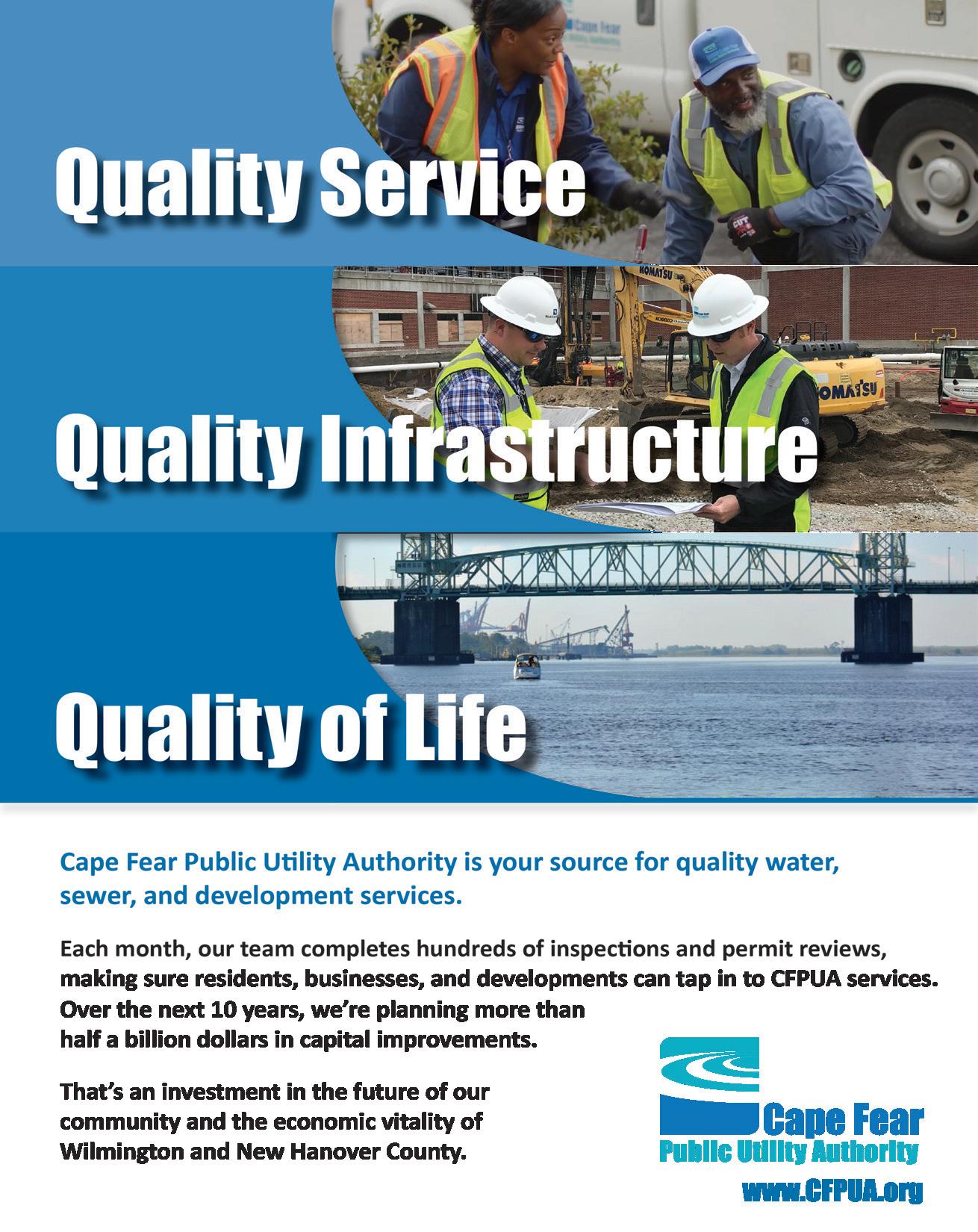






Put your business where it matters.
Advertise with the Greater Wilmington Business Journal and stay top of mind in Wilmington’s Business Community.


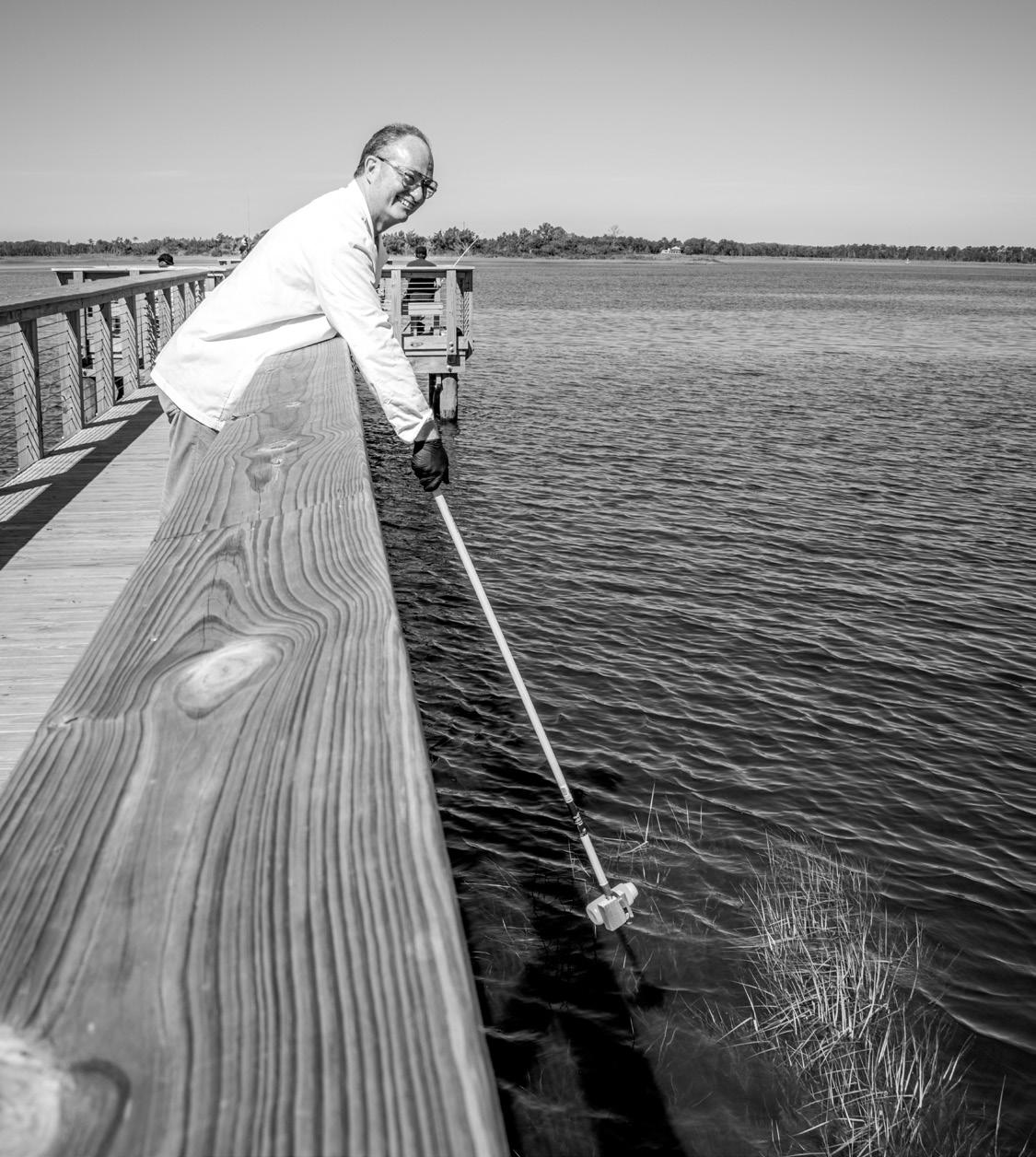


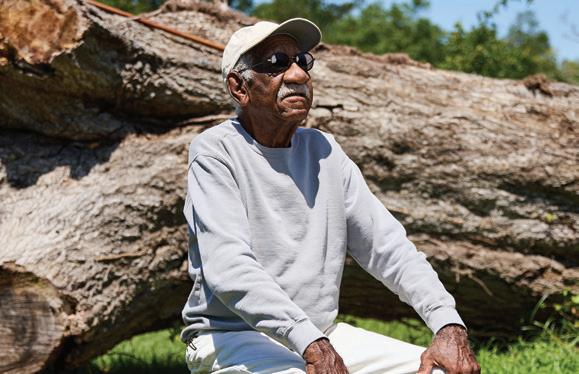


DARIA AMATO is a native New Yorker and School of Visual Arts graduate. Throughout her 30 years of experience, she has photographed a range of editorial, advertising, company branding and corporate clients. Amato photographed water testing officials (page 40) as well as the Wilmington Fire Department and Harper Peterson for a look at the New Hanover Community Endowment (page 26).

AUDREY ELSBERRY is a reporter for the Greater Wilmington Business Journal. Before starting at the Business Journal, she interned on the business desk at the Charlotte Observer and trained in New York City with the Dow Jones News Fund. Elsberry wrote about Duravax researcher Ying Wage (page 34), the Predicate Healthcare Performance Group startup (page 99) and updates on water quality issues for the region (page 40).

MALCOLM LITTLE is a portrait, editorial and brand photographer based in Wilmington. Originally from New Jersey, he began his creative journey as a professional dancer and choreographer before picking up a camera in 2021. Little photographed Ying Wang for the issue’s cover and story about Wang’s work on a longer-lasting flu vaccine (page 34). He also photographed Pine Forest Cemetery superintendent Jimmy Lofton for the story about endowment recipients (page 26). malcolmlittlephotography.com and @_malcolmlittle on Instagram

CECE NUNN has been writing and editing for more than 20 years, currently working as managing editor and residential real estate reporter for the Greater Wilmington Business Journal. She lives in Wilmington with her husband and two daughters. Nunn wrote about the latest happenings with the $1 billion-plus New Hanover Community Endowment for Money Talks (page 26).
SUMMER 2023 – $4.95
P ublisher
Rob Kaiser
rkaiser@wilmingtonbiz.com
P resident
Robert Preville
rpreville@wilmingtonbiz.com e ditor
Vicky Janowski vjanowski@wilmingtonbiz.com
M anaging e ditor
Cece Nunn cnunn@wilmingtonbiz.com
r e P orters
Emma Dill edill@wilmingtonbiz.com
Audrey Elsberry aelsberry@wilmingtonbiz.com
V ice P resident of s ales & M arketing
Angela Conicelli
aconicelli@wilmingtonbiz.com
s enior M arketing c onsultants
Maggi Apel
Craig Snow
M arketing c onsultants
Alexis Alphin
Jillian Hon
d igital c lient success c oordinator
Jessie Vincoli
jessie@wb360marketing.com
e V ents d irector
Jamie Merrill jmerrill@wilmingtonbiz.com
e V ents & M arketing c oordinator
Alecia Hall
ahall@wilmingtonbiz.com
a rt d irector - e ditorial
Suzi Drake art@wilmingtonbiz.com
a rt d irector - M arketing
Tara Weymouth tweymouth@wilmingtonbiz.com
M edia c oordinator
Julia Jones
jjones@wilmingtonbiz.com
d irector of f east W il M ington
Jessica Maurer
jmaurer@wilmingtonbiz.com
c ontributing P hotogra P hers
Daria Amato, Logan Burke, Megan Deitz, Madeline Gray, Aris Harding, Malcolm Little
s ubscribe
To subscribe to WilmingtonBiz Magazine,visit wilmingtonbiz.com/subscribe or call 343-8600 x201. © 2024 SAJ Media LLC
Money is such a sensitive subject, one of the prickliest. It’s stressful, it’s complicated and it’s a necessity.
So it shouldn’t be a big surprise that many eyes are focused on the actions of the New Hanover Community Endowment, a more than $1 billion fund with a stated mission to make life better for New Hanover County residents.
The endowment’s areas of focus, according to its website, are education, equity, community safety and community development. Funded in 2021 by the sale of county-owned New Hanover Regional Medical Center to Novant Health, the endowment has announced grants and investments of about $90 million since 2022.
Of that, $22 million is going to a collaboration focused on the area’s health care workforce. For a story about the endowment (Money Talks, page 26) in this issue, we talked to the vice chair of the endowment’s board of directors, grant recipients and people who have criticized the endowment’s progression.
With so much public money on the table, it’s safe to say the endowment will be under intense scrutiny for years to come.
In addition to a look at the endowment, this issue, which is primarily focused on the area’s health care industry, contains an article about a topic under even more scrutiny: our region’s water supply and efforts to remove forever chemicals from it (Testing the Waters, page 40 ). It’s such a prevailing topic here, President Joe Biden chose Wilmington to make
an announcement about a $3 billion federal investment in clean water efforts.
Another story in this summer WilmingtonBiz Magazine (Taking a Shot, page 35) explains an innovative effort at the University of North Carolina Wilmington that could lead to a universal and longer-lasting flu vaccine.
To round out this magazine’s offerings with a story in the news not directly tied to the health care industry, reporter Emma Dill examines the surge of smaller apartment projects in Wilmington (Filling In, page 18 ).
Even though many of these topics can be hard to address, talking about them (or in your case right now, reading about them) is the healthy thing to do.
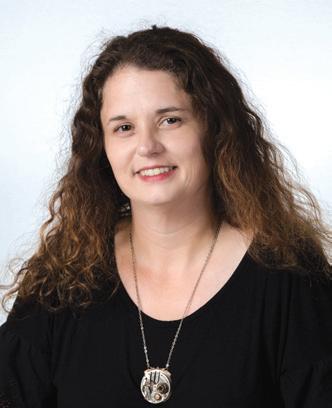 CECE NUNN, MANAGING EDITOR cnunn@wilmingtonbiz.com
CECE NUNN, MANAGING EDITOR cnunn@wilmingtonbiz.com


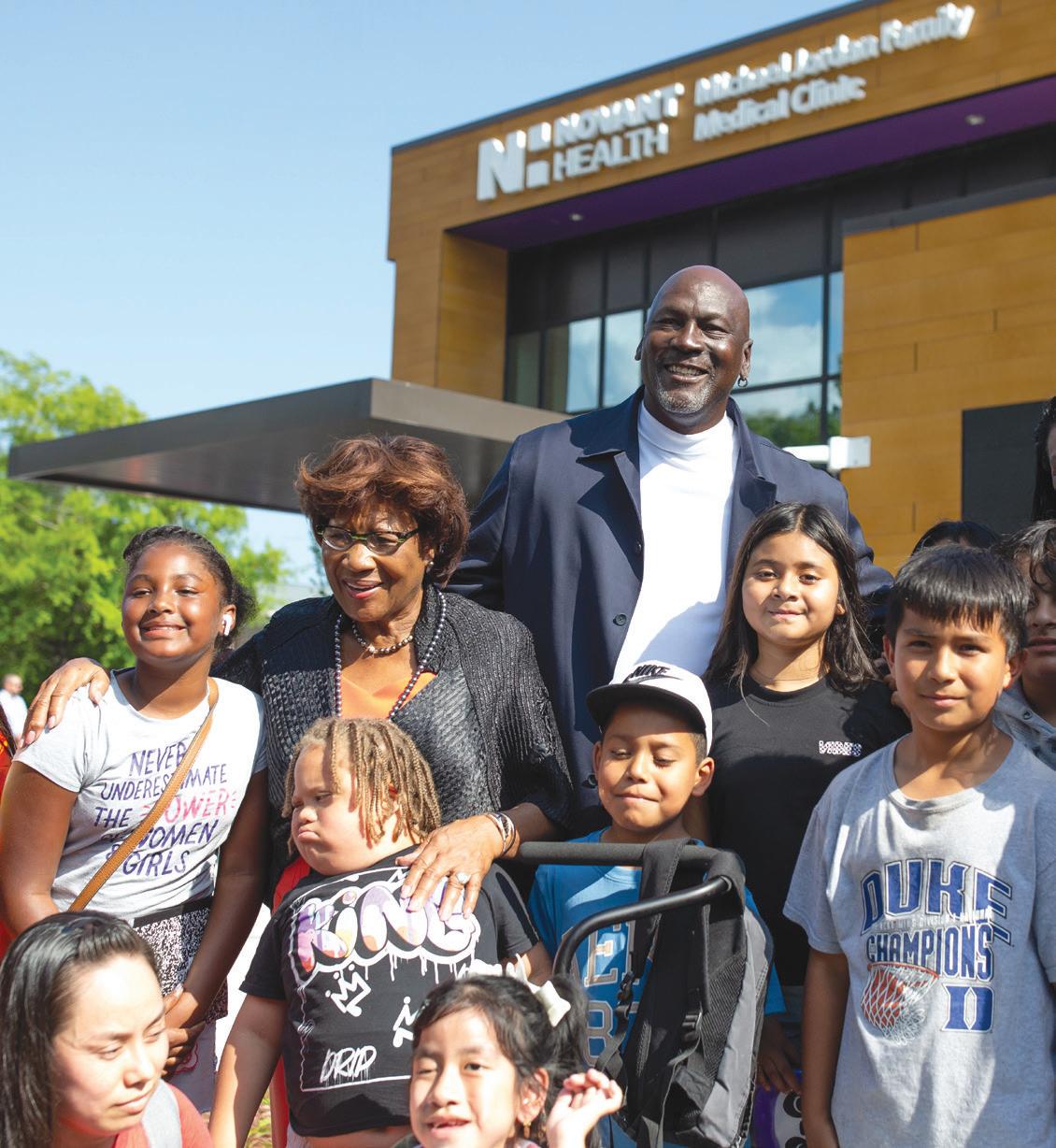
Michael Jordan returned to Wilmington in early May to cut the ribbon on the first of two medical clinics. Novant Health announced in early 2021 that the six-time NBA champion had donated $10 million to help open two Novant Health Michael Jordan Family Medical Clinics in New Hanover County. The first clinic, at the corner of 15th and Greenfield streets, opened in April, while site work has started on the second medical clinic near the corner of Princess Place Drive and North 30th Street. “We did it in Charlotte, and now we’re going to do it in Wilmington, which makes it even more special because this is home; this is where I came from,” Jordan said about the family clinics. “No matter how you see Michael Jordan, this is where I started.”




NUMBER OF ILM PASSENGERS IN 2023, A RECORD LEVEL FOR THE AIRPORT BY EMMA DILL
AS OFFICIALS GEAR UP FOR FUTURE GROWTH, several projects are getting ready to take off at Wilmington International Airport.
In May, state and local transportation leaders signaled plans to fund the widening of 23rd Street – a move airport officials say will improve traffic flow and accommodate future economic growth.
Meanwhile, airport officials embarked earlier this year on a $105 million project that will realign roads, straighten the curb at the airport’s terminal and reconfigure its parking area. ILM received $4 million from the Federal Aviation Administration to help fund the project earlier this year.
These efforts come as the airport has hit passenger records, serving more than 1.3 million passengers in 2023. ILM was the fastest-growing airport in North Carolina in 2023 and the fourth-fastest-growing airport in the U.S. based on an increase in the number of seats allocated to the airport by airlines.
ILM officials requested economic development funding from state transportation officials in March for the 23rd Street widening, committing $1 million toward the project.
Discussions around widening 23rd Street arose in recent years as ILM staff worked on the airport’s vision plan.
The project would add another northbound lane to 23rd Street between Martin Luther King Jr. Parkway and Airport Boulevard. The project will improve traffic flow into the airport, align with other capital improvements and accommodate future economic growth, airport leaders say.
NCDOT completed a feasibility study on the proposed road widening, and the Wilmington Urban Area Metropolitan Planning Organization (WMPO) has submitted the project for consideration as part of Prioritization 7.0, a process that helps determine when projects receive funding from NCDOT.
The estimated cost of the 23rd Street widening is $3.3 million, including $2.8 million in the project construction, utilities and right-ofway acquisition costs, according to NCDOT. The agency will contribute a combination of economic development and public access funding toward the project.



HAS EXPERIENCED SIGNIFICANT GROWTH OVER THE LAST FOUR YEARS.
As of April, it now boasts 16,000 more jobs than in the same month of 2019.
While almost all sectors have benefited from this growth, the health care sector was not only central to this transformation but is now the largest sector with 25,600 jobs and represents 17.1% of total employment.
While most people associate the area with the ocean and all its related activities, the economy has become considerably more diversified, and health care is leading the charge.
This growth comes amidst significant migration towards the region that now puts the share of people over the age of 65 at 19.1% in New Hanover County, 18.6% in Pender County and 35% in Brunswick County.
The aging of the population and continued population growth will translate into additional demand for health care services from residents.
Additionally, Wilmington’s

health care sector provides important services to neighboring areas, and that role will continue to grow as the state continues to age.
From an economic perspective, the fact that the health care sector provides services to not just residents but also individuals living in neighboring regions means that it serves as a basic sector that stimulates economic activity locally.
That is because the income generated by the sector exceeds local demand and can, therefore, create more economic activity through the multiplier effect in the form of jobs, and added income.
Another important dimension of health care’s growth is in its contribution to the area’s employment diversification and gradual shift from lower-paying jobs to higher-paying ones.
At the state level, for example, the average hourly wage for the leisure and hospitality sector is $19 but $33 in health care.
At the local level, this is
particularly important as the availability of higher-paying jobs will be important for continued economic growth and prosperity especially given the increase in housing costs.
From a supply/demand market perspective, the health care market is still a very tight market with only 0.6 job seekers for every job opening, which compares favorably to the 0.9 job seekers for every opening for the average job at the state level.
While this is attractive to job seekers, it also points to challenges in filling health care occupations, especially lower-paying ones.
The Wilmington region’s economy is bound to continue growing and attracting migrants from all over the country.
This population growth will mean continued demand for health care services, which means it will be important to map the sector’s growth to the changing demographics of the region to make sure there are enough skilled professionals in the area.
Mouhcine Guettabi is a regional economist with UNCW’s Swain Center and an associate professor of economics at UNCW’s Cameron School of Business.
MISSION IS TO PROMOTE ACTIVITIES THAT WILL IMPROVE THE ECONOMIC VITALITY AND SUSTAINABILITY OF THE COMMUNITY, DRIVING THE SUCCESS OF LOCAL BUSINESSES AND ENSURING A HIGH QUALITY OF LIFE FOR RESIDENTS.
The life science sector presents a prime opportunity for Leland to attract, launch and retain businesses that offer quality local jobs, develop employment centers and strengthen the town’s network of internationally competitive industries.
Life sciences in North Carolina supports approximately 830 companies, with 145 engaged in production and manufacturing. This sector has also produced 2,500 support companies and employs 75,000 people.
From a land use perspective, manufacturing typically yields a 3:1 return on investment for every dollar spent. Similarly, the town and its residents have expressed interest in attracting professional, high-wage jobs.

The average salary for biotechnology jobs is approximately $112,000, significantly higher than Leland’s median household income of $82,651.
The town of Leland has about 190 acres of available property zoned Innovation District, annexed in 2016 to support and encourage job-creating uses that fit the town’s character and desire for a place for creative, sustainable and entrepreneurial companies to start, grow or relocate.
This zoning district was created to attract advanced manufacturing, research and development, and associated support functions serving the community and region’s needs.
Developing these properties as employment centers could reduce commuting and attract amenities that support a “live, work, play and learn” community.
The southeastern region of the state has developed a thriving life science cluster that focuses on marine biotechnology, clinical research, industrial biotechnology, agricultural biotechnology and
biomanufacturing.
This cluster leverages public-private initiatives, such as (UNCW’s) Center for Innovation and Entrepreneurship, to facilitate technology transfers and entrepreneurial services.
While there is already an established community of life science companies in the Cape Fear region, new spinoffs continue to emerge due to research at UNCW and associated lab spaces such as UNCW’s CREST Research Park.
Between 2021 and 2022, this sector produced more than 5,500 biological and biomedical degrees and more than 4,300 engineering degrees. UNCW has created new programs, such as the Ph. D. in pharmaceutical chemistry and the bachelor’s in biochemistry, further supporting the potential workforce to attract life science companies to Leland.
Leland is strategically positioned at an ideal location for state, national and international commerce.
The nearby Port of Wilmington and the Wilmington International Airport enable the efficient transportation and shipment of climate-sensitive products and materials essential for biomanufacturing and research.
Direct access to several interstates and highways connects Leland to class A commerce parks
and cold storage facilities in the region, providing seamless connectivity to the state’s western ends and along the Eastern Seaboard.
Lastly, local resources like Brunswick Community College’s Small Business Center and its customized training program play a crucial role in Leland’s appeal to the life science industry. The college supports startups by offering coworking spaces and customized training, ensuring a pipeline of skilled and certified graduates ready to contribute to advanced manufacturing operations. This makes the region attractive to businesses looking to capitalize on the talented workforce and growing population.
Leland is at a pivotal time of transition.
Residents describe the town as a “growing, thriving community” with a “small-town quality of life and access to city amenities.”
This strategy envisions Leland continuing to enjoy the best of both worlds, growing and thriving while preserving its character. The goal is to fulfill residents’ desires for diverse amenities, health care and quality local jobs without losing established small-town roots.
Barnes Sutton is the town of Leland’s economic and community development director.
REACTIONS, OPINIONS AND QUOTABLES FROM OUR ONLINE SOUNDING BOARDS
WHO IS SOMEONE PEOPLE SHOULD KNOW ABOUT IN THE REGION AND WHY?
“ DR. DANIEL GOTTOVI – founded Wilmington Health Associates, Elderhaus and Hospice here in Wilmington.” -DEBORAH JOYCE GOODMAN
“ BONNIE MONTELEONE , founder of the Plastic Ocean Project.” -SUSAN ZEDELLA MILLE r
“ CEDRIC HARRISON . He started with Support the Port, giving back to the community. Then he brought his dream to life, teaching black history with a tour of the community he grew up in (with) WilmingtonNColor.” -CHELL NEEMA WATKIN s
“ KEVIN MURPHY , founder of Ocean Cure.” -RANDY LEE
“ JANET KANE , CEO of Cape Fear Realtors.” -AMANDA PARMER
“ DAVID JOHNSON of Johnson Nursery in Willard. Not only do they have an amazing wholesale nursery and garden center, but they have begun an incredible project called The Gardens of Southeastern North Carolina. It’s a beautiful place, but the plans for continued expansion are awesome. He and his family are visionaries.” -CURT SIMPSON
“ KERRY KASOTSKY (Musical Chairs Speed Networking Events) is such a great connector of people in business.” -MICHELLE VALENTINE FOURNIER
X (FORMERLY KNOWN AS TWITTER) POLL: @WILMINGTONBIZ
DOES YOUR ORGANIZATION HAVE A DEI TRAINING PROGRAM?
EDITOR'S NOTE: The Greater Wilmington Business Journal is launching a regular series of op-eds, opinion columns about ideas for sparking economic growth in the region. If you have a column topic to be considered, email editor@ wilmingtonbiz.com
“ALMOST EVERYTHING THAT’S BEING DONE DOWNTOWN are apartments being built. So there are very few for-sale units in the downtown area.” -KEITH BEATTY, OF INTRACOASTAL REALTY’S BEATTY PITTMAN TEAM, ON THE PLAN TO CONVERT RIVER PLACE’S APARTMENTS INTO MORE CONDOS AT THE MIXEDUSE DEVELOPMENT.






ilmington might land another maritime attraction.
The Wilmington City Council recently supported the N.C. Submarine Museum Foundation’s idea to build the museum in the Port City.
In 2008, the Navy commissioned the USS North Carolina SSN 777 submarine in Wilmington, and Wilmington has many more things going for it as the foundation works to make the museum a reality. Those attributes include proximity to and understanding of the ocean and already holding one of the state’s most popular maritime attractions, the Battleship North Carolina.
The N.C. Submarine Museum Foundation was started for the families of the sailors deployed on the USS North Carolina SSN 777, the
USS Charlotte SSN 766 and the USS Asheville SSN 758. The “SS” denotes a submarine, and the “N” stands for “nuclear-powered.”
“There are 1,500 family members across three submarines that we support,” said Christopher Perrien, executive director of the submarine museum foundation. “These boats go on patrol for seven months at a time underwater, and that puts a lot of strain on the average family.”
A museum would continue to support military families and honor submarine veterans but also provide science and math education and inspire some to enter the field of submarine technology.
Perrien said the submarine museum could be a $35 million to $65 million above-the-surface facility rather than a decommissioned submarine.
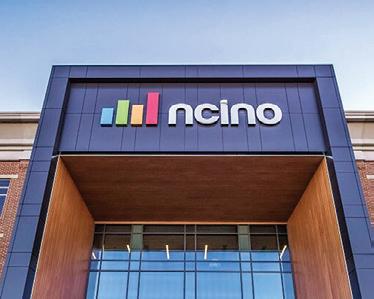
nCino issued its first quarterly earnings report of its 2025 fiscal year on May 29, beating analysts’ expectations in both revenue and earnings-per-share.
The Wilmington-headquartered cloud-based banking software company reported $128 million in total revenues, about $1.5 million more than Zacks Investment Research’s predicted revenue based on its analyst poll. The same goes for nCino’s 19-cent earnings-per-share, which beat analysts’ predictions by about 5 cents for the first quarter, the threemonth period ending April 30.
$593.6M
Goods exported from the Wilmington MSA in 2022 (latest year data is available) Source:U.S. Trade Representative’s Office
IN MAY, ONE OF THE LARGEST PRIVATE FERMENTED BEVERAGE MANUFACTURERS IN NORTH AMERICA, FEDUP FOODS, ANNOUNCED IT WAS EXPANDING INTO WILMINGTON.
Sarah Mullins and Jeannine Buscher founded FedUp Foods in Asheville after making kombucha together for their children. Now, FedUp Foods manufactures kombucha, pre- and probiotic sodas, Tepache and functional cold brew coffee.
Company officials did not say whether they purchased the building at 715 Greenfield St., formerly occupied by Tru Colors Brewing. They said they are now actively recruiting, hiring and training a local team and look to begin producing by this fall.
The company’s Wilmington facility is expected to produce more than 100,000 barrels of product a year.
Below is a recent Q&A with FedUp Food’s chief executive officer David Gray. To read more, go to WilmingtonBizMagazine.com.
WHAT MADE FEDUP FOODS CHOOSE WILMINGTON TO EXPAND IN?
“Over 15 years ago, we planted roots in Marshall, North Carolina, a small town nestled in the Blue Ridge mountains right outside of Asheville,
 DAVID GRAY CEO, FEDUP FOODS
DAVID GRAY CEO, FEDUP FOODS
North Carolina. Three years ago, we opened our second facility in Erwin, Tennessee, and now Wilmington makes our third location on the East Coast.
Choosing Wilmington was a carefully considered decision driven by its strategic location, which offers access to sea and rail, along with a vibrant community and a strong appetite for growth. The existing building layout, location and infrastructure, including cold and dry storage, fermenting tanks and equipment, provided an excellent foundation for our expansion.
Not to mention, the investment in the city’s infrastructure and the enthusiastic support we received from civic leaders, including
(Wilmington) Chamber of Commerce and Wilmington Business Development, was further evidence that Wilmington was the right next step for us.”
WHAT PRODUCTS WILL THE CASTLE STREET FACILITY PRODUCE?
“We are focused on making the best quality, functional, good-foryou beverages accessible to all. This means sourcing with intention, using organic ingredients, and prioritizing fair trade-certified and regenerative growers, all while maintaining the highest safety and quality standards. Wilmington is an ideal location for us to launch our cold brew coffee program and expand the capacity for our growing range of functional fermented beverages, such as kombucha and pre- and probiotic sodas.”
AS A PRIVATE LABEL MANUFACTURER, YOU MAKE THE BEVERAGES FOR A VARIETY OF BRAND NAMES. HOW HAS THE COMPANY GROWN ITS ROSTER OF CLIENTS IN RECENT YEARS?
“From the beginning, we have approached business differently, guided by our mission and high environmental and social impact standards that prioritize people, planet and prosperity. This philosophy shapes our decisions, from investing in our team to adopting sustainable manufacturing practices and partnering with ethical and regenerative growers. Our people-first, values-driven approach has led to long-term, meaningful partnerships, which have been key to growing our client roster and
sustaining our momentum.
When you do private label right, it is an opportunity to offer really high-quality items at the most affordable and accessible price point – while lifting up and supporting growers and suppliers who are not only sustainable but also regenerating the environment for future generations. This is what makes us not just incrementally different, but fundamentally different.”
FEDUP DESCRIBES ITSELF AS NORTH AMERICA’S LARGEST PRIVATE-LABEL MANUFACTURER FOCUSED ON FERMENTED FUNCTIONAL BEVERAGES. WHAT DRINKS FALL UNDER THAT CATEGORY AND WHAT’S THE CONSUMER DEMAND OUTLOOK FOR THEM?
“Fermented functional beverages are drinks that have undergone the traditional and natural method of fermentation, offering benefits beyond refreshment. We produce a variety of beverages like:
Kombucha: A fermented tea known for its beneficial bacteria, including probiotics, and potential digestive health benefits.
Prebiotic Soda: A better-for-yousoda that is low in sugar and features plant-based fiber and fermented tibicos cultures from the Opuntia cactus plant.
Tepache: A fermented pineapple beverage whose origins can be traced back to the indigenous peoples of Mesoamerica.
The world of beverages and consumer preferences are ever evolving, but what we do know is that people are seeking more than just hydration. They want beverages that provide holistic, multifunctional benefits for both the mind and body while also being good for the planet and their wallet. We’re seeing this not only in the beverage category but across all categories of food and beverage.”

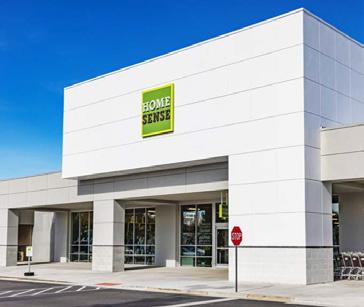




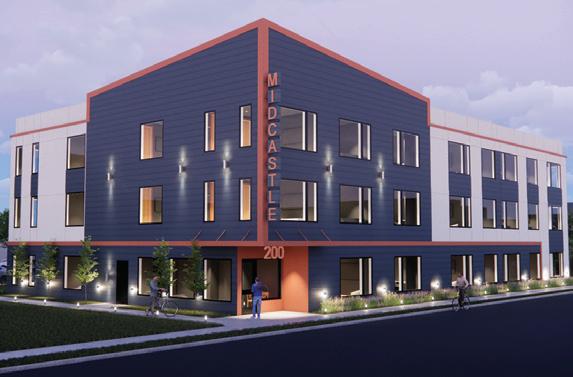

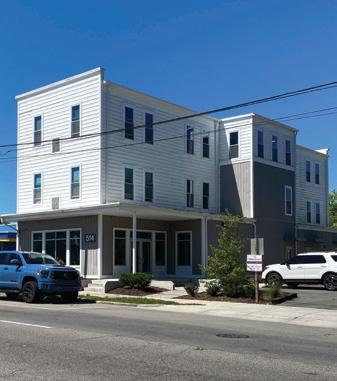
THE PEARL STUDIO 17



On a handful of vacant lots just south of downtown Wilmington, apartments are popping up one by one. At the corner of Castle and South Eighth streets work is starting on a 10-unit apartment building. A few blocks away, another proposal would bring 82 apartments to a block between Dawson and Wooster streets.
Back on Castle Street, construction has kicked off on the first phase of Midcastle, a 98-unit apartment project being built on the l of a former WAVE transit bus facility.
Midcastle is the biggest contiguous project local developer Dave Spetrino said he’s ever done. That’s because at 1.5 acres, the site is the largest single piece of land he’s developed. Spetrino specializes in building the small- to mid-sized projects that dot commercial corridors south of downtown.
Near the corner of Wooster Street and South Fifth Avenue, Spetrino renovated The Jewel – a 1970s-era building – into a small-scale apartment complex in 2015 and nearby completed The Pearl, a 38-unit building, in 2019 and the 32unit Mini Pearl in 2020.
Maine-based real estate investment firm Bush Watson purchased all three projects for $11.5 million in 2021. Two years earlier, local developer Matt Scharf sold Urban Oasis Apartments, his 11-unit project on Castle Street, to a Bostonbased investment group for $2.25 million.
Spetrino said those sales helped push other local developers to consider the type of small projects that would fit onto vacant lots in areas just beyond the traditional borders of downtown Wilmington.
The construction of multifamily projects – both large and small – is relatively new in the downtown market. Wilmington architect Clark Hipp remembers having conversations with other downtown leaders in the early 2010s about how to bring more density and more people back to the area.
Hipp has worked on projects in the downtown area since 1987, he said. When a development boom started about four years ago, he started fielding calls from out-oftown developers hoping to tap his knowledge about local development and zoning guidelines.
“They moved to town and started looking at larger projects, and because Wilmington is fairly constrained, they also began to look at infill projects,” Hipp said. “That’s where I kind of got involved.”
The multifamily boom downtown was fueled by the region’s growing population, especially during the work-from-anywhere COVID-19 era, and a gap in the housing market, Hipp said. While single-family homes
dominated the market, there was a lack of smaller-scale, more affordable housing alternatives such as townhomes, duplexes and apartments.
Those housing types are typically referred to as “missing middle” housing, said Linda Painter, the city of Wilmington’s director of planning and development.
“Missing middle is everything in between single-family and your traditional walk-up apartments – duplex, triplex, quadruplex, townhomes, courtyards, two-story walkups,” said Brian Chambers, the department’s assistant director. “Everything in the middle that’s missing.”
It’s a housing type that planning staff in Wilmington are trying to encourage because it can help bring denser construction to small- or medium-sized vacant lots that are ripe for infill development.
“We’ve got to provide density where it makes sense because we’re a growing city,” Chambers said, “and we are charged with planning how we’re going to grow.”
Because missing middle housing takes shape in smaller complexes, the units – whether for rent or for sale – can often be more affordable, Painter said. Building smaller infill projects on vacant lots also generates more housing supply.
“The idea is that if we can increase the number of units overall, as well as increase the types and options for people giving them more choices,” Painter said, “hopefully that will also bring affordability down and make units overall more affordable for people living in the area.”
In 2021, city leaders adopted a revised land development code that made changes to encourage the construction of missing middle units. For instance, the revision allowed some missing middle housing types, including townhomes, duplexes, triplexes and quadruplexes, to be built in residential districts that previously only allowed singlefamily homes.
Painter said since the change went into effect, city staff have noticed an uptick in applications for the construction of missing middle units.
Those small- to mid-scale projects are often less expensive for developers to construct, especially when building on infill lots, said Todd Toconis, owner of Town & Country Real Estate.
“It makes for some affordable projects because you’re


not buying 30 acres, you’re not putting in parking lots, you’re not putting in retention ponds, you’re not putting in all the infrastructure required on most typical multifamily sites,” he said. “Those infill lots … are very desirable for mid-grade developers.”
With current higher interest rates, the lower cost of a small- or mid-sized project is also less of a risk, Toconis said.
Zoning plays a big role in drawing developers to certain tracts of land, especially along commercial corridors like Castle, Wooster and South 17th streets. City efforts, including the Southside Small Area Plan adopted in 2009, and rezonings along Castle Street that replaced the antiquated Mainstreet Mixed-Use zoning district with the Urban Mixed-Use or UMX district, helped shape development patterns the area is seeing today, Chambers said.
“There’s a lot of deliberate actions we’ve taken over the past two decades that are just now coming to fruition,” he said.
The UMX zoning district allows for the construction of denser
multifamily projects by right, which means developers don’t have to go through what can be a lengthy and contentious zoning process, Spetrino said.
“I’m rarely having to do rezonings in these areas. Rezonings are unbelievably painful, they’re very expensive, and you don’t even have an answer even if you spent … a year or more trying to rezone something,” he said. “To the city’s credit, they did a really good job of adjusting their zoning, specifically in places where you’d expect to see density, and there’s also not going to be an outcry.”
Because of the UMX standards, Scharf was able to build Studio 17, a 32-unit apartment building on a 0.7acre tract near the corner of Castle and South 17th streets.
“Geographically, we’re a small city, land-wise, and so all you can do is increase the density or go up, but there’s a limit of what that can be,” Scharf said.
By the city’s estimates, between 10% to 15% of the land within Wilmington’s city limits remains undeveloped.

That has forced developers to get creative with infill development on smaller lots.
Hipp has worked on designs for many of those projects, including the 10-unit building near the corner of Castle and South Eighth streets and Sapphire on 5th – the 82 apartments planned between Dawson and Wooster streets.
Required setbacks only make the area for potential development smaller, and parking adds more constraints, Hipp said. It’s parking considerations that often determine for Spetrino how many apartments he can include in a project, he said.
As work forges ahead on Midcastle and the other mid-scale projects along Castle, Wooster and South 17th streets, Hipp sees the potential for similar types of construction in and around other emerging districts – along Greenfield Street on the Southside, along Wrightsville Avenue as the Cargo District stretches east and around the growing Soda Pop District.
“I think,” Hipp said, “everybody’s looking for the next spot.”


Agood friend’s end-of-life experience at Lower Cape Fear LifeCare back in 2006 introduced Gwen Whitley to the nonprofit hospice and palliative care organization, and the now president and CEO has never looked back.
For seven years, Whitley has led the organization that serves 1,200 patients daily across a ninecounty service area.
Whitley’s friend, who was only 36 at the time and had advanced cancer, received inpatient treatment at Lower Cape Fear LifeCare’s (LCFL) care center in Wilmington. As a veteran nurse, Whitley had experienced countless deaths in “sterile hospital” settings, but this hospice death was entirely different. Her friend had requested that she feel the warmth of the sun on her face in her final moments, so her bed was pushed out onto the patio of her hospice suite. She took her last breath outside surrounded by family, friends and her hospice team.
The experience had a profound impact on Whitley.
“To see that there was a place other than a sterile hospital where patients could come to, it was a peaceful, touching experience,” she said. “And I thought to myself, I have to be a part of this. It was so powerful and phenomenal.”
At the time, Whitley was a regional vice president for a home health agency. A native of Caswell County, Whitley built a highly successful nursing career prior to becoming an administrator. From her first introduction to LCFL in
2006, it took two years before a job opportunity opened up. She started as a clinical director, a position that was technically a demotion, but Whitley jumped at the chance to be involved with the organization. She has since advanced through the ranks, including stints as the vice president of clinical services and then chief operating officer before her current position as CEO.
Whitley sees her role to be first and foremost about upholding the organization’s mission, which she describes as “identifying and making sure that we are serving anyone who needs hospice, palliative care and memory partners care. The mission is to reach all of those vulnerable people in the community who need end-of-life care and care for a serious illness.”
As CEO, Whitley is the face of community engagement and outreach. She actively collaborates with health care agencies within the broad region that LCFL serves, educating about services and opportunities to expand their reach. She also forms new partnerships with hospitals who need support in their hospice and palliative care services, such as LCFL’s recent expansion to serve UNC Health Southeastern hospital in Robeson County.
LCFL serves an expansive nine-county area of Eastern North Carolina, which recently expanded to include Horry County, South Carolina. Whitley successfully mitigates this challenge of serving a broad area as one unified organization by meeting quarterly with staff in every location to share information about what is going on with the agency and recognize service milestones. “It’s important to me to make all offices feel like we are operating as one,” she explained.
On the palliative care side, the LCFL team provides specialized medical care for patients with complex medical diagnoses. Palliative care focuses
on coordinating medical care, managing pain and symptoms and alleviating stress, all with the purpose of providing a better quality of life for patients fighting serious illnesses.
“With palliative care, we focus on the patient receiving the right care at the right place at the right time,” Whitley said.
Part of Whitley’s job is to educate hospitals about how palliative care is not only good for patients, but it is good for a hospital’s bottom line.
“Palliative care can save hospitals money,” Whitley said. “Patients will be discharged sooner with a good plan of care.”
Ninety-five percent of palliative care patients are treated at home by nurse practitioners who collaborate closely with the patient’s primary care physician, Whitley said. LCFL currently operates palliative care clinics within several major local medical facilities, including the Novant Health Zimmer Cancer Institute, Cape Fear Heart Associates, Wilmington Health and Novant Radiation Oncology.
On Sept. 1, LCFL is slated to open the first freestanding clinic for palliative care in North Carolina.
LCFLC sought to establish the new outpatient palliative care clinic, which will be located on Shipyard Boulevard, because they recognized a need in the area. For patients who are well enough to travel to an outpatient clinic, they can be seen more quickly and more efficiently by the outpatient clinic. A physician and a nurse practitioner will alternate care in the clinic five days per week with the ability to see up to 30 patients per day.
Sometimes with home palliative care, patients have to wait two to three weeks before a provider is able to travel to their location. The outpatient clinic enables LCFL staff “to see patients more quickly and get them on a plan to work toward their goals,”


Whitley explained.
Another service of LCFL is Memory Partners, which provides care, resources and support for dementia patients and their loved ones. Memory Partners educates caregivers on the different phases of dementia as well as how to take care of and interact with their patients. A team of RNs, social workers and trained volunteers provide support in several areas, including safety assessment, advanced care planning, art therapy and counseling support. Through a $1 million federal grant, Memory Partners is now able to expand services by offering muchneeded vouchers for respite care.
As a long-term goal, LCFL would like to build a freestanding Memory Partners building in New Hanover County to serve as a hub of education and support for dementia patients and their caregivers. Whitley hopes to achieve this goal within three to five years.
Looking ahead, LCFL plans to continue seeking opportunities to serve the greatest needs in this area. From her first interaction with hospice care until today, Whitley remains inspired by the organization’s mission and goals.
“What a privilege it is that these families allow us in their homes when they are so vulnerable,” Whitley said. “Just knowing that what we are doing is making an impact in the community. I am very proud to lead this organization.”
Gwen Whitley was part of last year’s WilmingtonBiz 100 as an Influencer. This year’s group will be announced in late September and highlighted in the December issue of WilmingtonBiz Magazine.
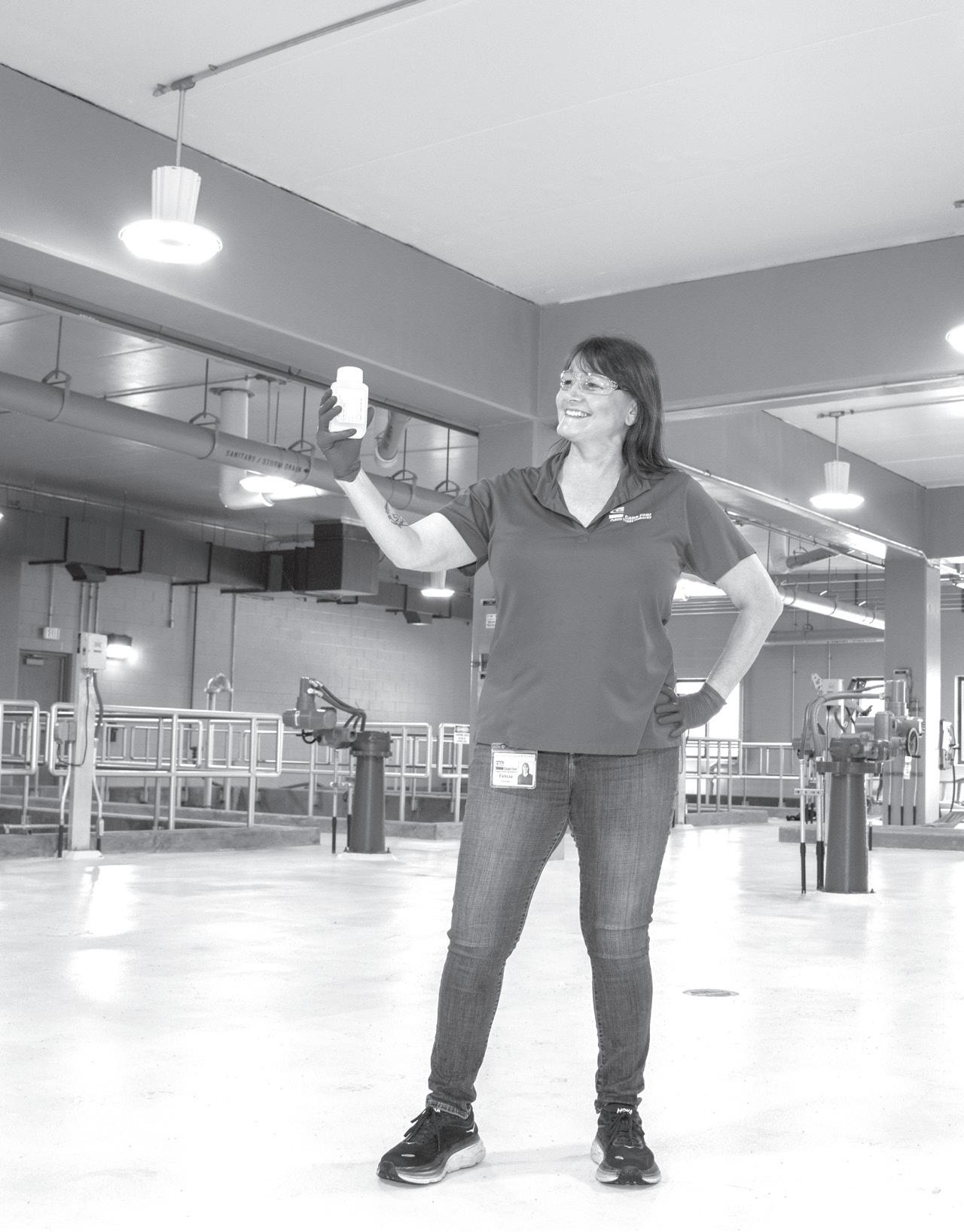
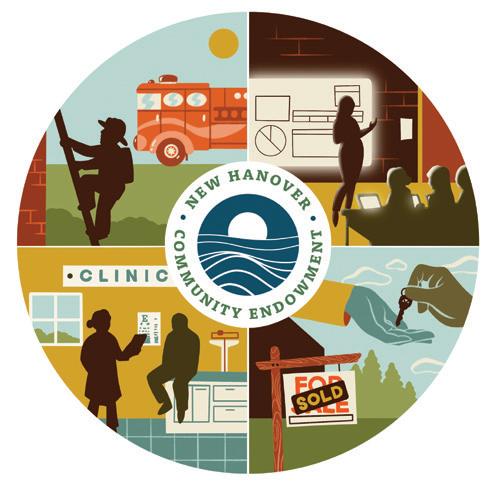
INE FOREST CEMETERY OFF NORTH 16TH STREET LANGUISHED UNDER WEEDS ABOUT 20 YEARS AGO.
“You couldn’t identify anything,” said Wayne Lofton, a member of the Wilmington landmark’s board of directors.
He said the 15-acre resting place, established in the 1870s for members of Wilmington’s Black community and other minorities, contains the graves of prominent Black residents and victims of Wilmington’s 1898 massacre.
His father, Jimmy Lofton, is Pine Forest’s longtime superintendent. “What he was able to do out there has been nothing short of miraculous, and we fight very hard to continue to do it,” Wayne Lofton said.
That fight and the educational programming the cemetery provides require money. In 2022, the cemetery got a $10,000 boost through a grant from the New Hanover Community Endowment. That year, the cemetery board was one of 110 organizations and institutions to be awarded grants in the endowment’s first round of grant funding, and the cemetery board was grateful for the funds, Wayne Lofton said.
Like Lofton’s praise, the endowment’s first two years have come with gratitude. But they have also come with some criticism.
Founded in 2021 from the sale of New Hanover Regional Medical Center to Novant Health, officials with the $1 billion-plus endowment have deployed or pledged to deploy nearly $90 million (as of May 29). Because NHRMC was a county-owned hospital, the endowment requires that grant funding be used in New Hanover County.
The endowment’s first grant round doled out a little over $9 million.
The inaugural cycle emphasized responsive grants, said Shannon Winslow, vice chair of the endowment’s board of directors. The money went to existing programs to help them accomplish a variety of goals, from buying equipment to funding positions.
But some nonprofit officials whose organizations received grants in the first cycle were dismayed to be left out of the second round, announced in December and made up of $53 million worth of multi-year “strategic”
grants.
“I don’t think people expected to have no money or hardly any money come through for the smaller organizations that were looking for capacity building and to be able to do more locally that they wanted to do,” said Connie Parker, founder of The Alliance for Cape Fear Trees, which received a $16,000 endowment grant in 2022.
A sampling of other nonprofits that received grants two years
ago responded to WilmingtonBiz Magazine’s questions about their experience with the endowment.
Dawn Ferrer, executive director of A Safe Place, said the $148,000 grant her organization received in 2022 helped fund her position for a year and pay the mortgage for The Farm, a long-term residential program for victims of commercial sexual exploitation and sex trafficking.
“We applied for housing assistance in 2023 to help fund the construction of another cottage on the property to increase capacity, but it was denied,” Ferrer said.
Ferrer, a member of the

LARGEST MULTIYEAR & STRATEGIC GRANTS
$22.3 M HEALTH CARE TALENT COLLABORATION
$19 M
$6.8
$5.5 M
$5
$3.3
$3.2 M COMMUNITIES IN SCHOOLS OF CAPE FEAR
$2 M MEDNORTH HEALTH CENTER
$1.7 M
$1.2 M
$250K
$200K
$200K
endowment’s Community Advisory Council, said the endowment board didn’t tell the council that affordable housing requests would not be funded in the December 2023 announcement. She said she thinks the endowment board “needs more transparency to build up community confidence. This should include meeting with local nonprofits to see firsthand where the money would be most effective for the goal of ‘transformational change.’”
Addressing concerns about affordable housing grants, endowment officials unveiled a more-than-$19 million affordable housing investment strategy in May.
“This investment approach aims to mitigate the ongoing affordable housing crisis in the area by supporting existing housing and preventing displacement, facilitating the production of new affordable housing units and exploring the creation of a capital impact program for future housing projects,” endowment officials stated in a May 29 news release.
While no specific nonprofit groups were mentioned in the announcement, the release said endowment leaders “are in communication with nonprofit housing providers identified in the 2023 grant cycle.”
It’s important for the community to know, Winslow said, that the 2023 cycle received $336 million in grant requests, including housing proposals. But affordable housing is a complex issue, she said, with some organizations duplicating services and endowment officials needing more time to “wrap their heads around and better understand” what would make the most sense strategically to address the problem.
Affordable housing groups responded favorably to the May announcement.
“This is a great first step,” said Pastor Rob Campbell, of New Beginning Christian Church, who also serves as CEO of New H.O.P.E.
CDC, in a statement May 30. “Their announcement goes a long way toward creating an atmosphere where we can all work together to help solve one of the biggest issues of our time.”
The grants announced in December mainly went to large groups and institutions, with $22 million split between those involved to boost the health care workforce. At the same time, Novant announced it would separately invest in $10 million toward training health care workers in the region.
The endowment recipients, part of the Health Care Talent Collaboration, were the University of North Carolina Wilmington, Cape Fear Community College, New Hanover County Schools and the Wilmington Chamber of Commerce Foundation.
“I think the greatest danger for the endowment is that so many organizations are looking to cash in on the large pot of money available,” said nonprofit leader Robert Ferber. “I’m especially concerned about local government and other related institutions, such as schools, treating the endowment like their own rainyday fund, with the attendant concerns about political considerations and connections overshadowing everything else. I do think that more transparency is needed.”
Ferber is president of the board of directors of a nonprofit focused on safe and supportive affordable housing for people with autism and other neurodiverse conditions. His group, IndependentWorks, received $1,000 in the first grant cycle but was denied a requested $2,500 grant the following year.
Kids Making It received an “extremely helpful” $132,500 grant from the endowment in 2022, allowing the nonprofit to buy a highquality commercial dust collector for its woodshop, said Kevin Blackburn,
Wilmington Fire Department firefighters Arden Williams (from left), Lt. Sam Adams and Christopher Robinson show off the department's new high-water training vehicle, which was purchased with a grant from the New Hanover Community Endowment.

executive director. Kids Making It teaches woodworking to children and teens and aims to build their vocational and life skills.
Features of the grant-funded system “have also improved our clean-up process, and the funding allowed us to do a deep clean of all our HVAC systems – something not done for years and much needed, given the amount of sawdust our shop generates,” Blackburn said. “We hired an additional after-school instructor with this funding, improving the experience of our students, improving the quality of our instruction,
mentorship and ratio of teens to instructors.
“Collectively, all of these improvements have had a wonderful and significant impact on the safety of our shop for the kids we serve.”
The organization also received a more than $103,000 grant in 2023.
But Blackburn would like to see increased transparency from the endowment and “strategic grant funding awarded to more nonprofits that don’t have the professional fundraising teams large institutions have at their disposal.”
Moving forward, Winslow said the endowment will have a rolling grant cycle.
“It allows us more flexibility to meet people where they are when projects are ready,” she said.
An example, she said, is the endowment’s investment of nearly $6.8 million over three years in the Northside Food Cooperative. The planned grocery store would help alleviate one of the county’s food deserts. That funding announcement came after the unveiling of the

December grant news.
Kids Making It officials plan to apply for additional endowment grants.
“We have grown exponentially in the past couple of years, and the endowment’s funding has been instrumental in this, particularly the 2023 grant funding we were fortunate to receive. We have big plans still unrealized, and we are excited about submitting a strategic grant in collaboration with another nonprofit (or nonprofits) in the future.”
Local nonprofits will likely get used to the endowment’s possibilities, said Hannah Gage, who was co-chair of the endowment’s board when it
formed in 2020 in preparation for the funding transfer from the hospital sale.
“Before the New Hanover Community Endowment was established, the nonprofits here had to claw and scratch for every penny and apply for federal grants and apply for state grants, and they were competing with thousands of others,” Gage said. “And the grant-making process for them was do or die – if they didn’t get a grant, it would determine whether they could turn the lights on or whether they could continue with certain programs. … You look at each grant cycle as a win or loss.”
Gage, who was not reappointed to the board last year, said she believes the county’s nonprofit community over time “will begin to see that there’s always going to be another chance.”
In April, an organization called Heal Our People’s Endowment sent a letter to Attorney General Josh Stein calling for Stein to review the New Hanover Community Endowment’s performance and abrupt leadership changes.
In its letter, the group stated that the $22 million going to the


health care workforce initiative “will directly benefit Novant through nurse/ health worker training programs. Such a massive allocation to one sector contravenes the mission to foster transformative change across all the community. There’s no guarantee those trained will even remain in (New Hanover) County.”
Harper Peterson, a former state senator, former Wilmington mayor and founder of Heal Our People’s Endowment, said, “It struck people that here we have a corporate health care entity, based out of WinstonSalem, reaching into the endowment to help with their nursing pipeline and recruitment and retainment.”
Winslow said the health care workforce funding will directly benefit New Hanover County residents in various ways.
“You’re helping patients, but you’re also helping that individual realize a higher-paying job as well,” she said. “So it’s a win-win from so many different angles.”
Also in April, the endowment’s Community Advisory Council, an
DEC. 2020
Gage as chair and vice-chair, respectively.
BROADHURST GAGE


18-member group with no voting power, sent a letter with concerns about what they saw as a lack of engagement from the endowment board. The attorney general required the endowment to have a CAC before signing off on the sale of New Hanover Regional Medical Center to Novant Health.
Endowment board chair Bill Cameron and Winslow met with some members of the CAC to address concerns.
While Ferrer could not attend those meetings, she said, “I think things will change.”
Winslow said the “advisory council is integral to what we do. Moving forward, we’ll continue to find new and additional ways that we can incorporate their expertise and their feedback.”
Gage said the endowment, which has held community listening sessions since forming, needs to listen seriously to constructive criticism “and figure out a way to better communicate.”
She said the endowment didn’t have the staff to oversee everything
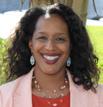

The board expands to 13 members after input from N.C. Attorney General Josh Stein during his review of the hospital’s sale to include board members “with experience working on the issues that the endowment will support.” Khadijia Tribie Reid and Edelmira Segovia join the board.
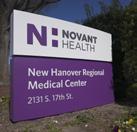
The sale of county-owned New Hanover Regional Medical Center to Novant Health closes. Proceeds from the sale are used to fund the $1.2 billion New Hanover Community Endowment. (Another $75 million is added in 2023 after escrow accounts are settled from the sale.)
coming in from nonprofits for the first round of grants.
“We had to hire contract people to help us. That’s not the case now, and hopefully, moving forward, the process will get more refined, the communication to the nonprofits will be improved, and everyone will have a larger understanding of what each grant cycle represents,” Gage said.
A nearly $2 billion endowment covering 18 counties in western North Carolina, Dogwood Health Trust, held community listening sessions with its grantees during the first quarter of 2024 “to learn from their experiences and understand their constraints,” said Susan Mims, CEO of the Asheville-based trust, which became a separate entity in 2019 after the sale of nonprofit Mission Health to private company HCA Healthcare.
“We heard about the need for convening and collaboration and a desire to grow and strengthen our collective responses to the challenges within our region,” Mims said. “This feedback has helped to inform the development of a five-year strategic
William Buster is announced as the endowment’s first president and CEO. JAN.2022

MARCH 2021 DEC. 2022

The first round of grants is dispersed – $9 million to 111 New Hanover County groups for one-time smaller grants ranging from $1,000 to $250,000
More than $300,000 is given to help Wilmington Housing Authority residents who were displaced because of mold issues.
framework for Dogwood that we look forward to sharing this fall.”
Along with concerns about communication, some members of the Wilmington community were caught off guard when endowment officials announced the resignation of New Hanover Community Endowment CEO William Buster in February.
Before leading the New Hanover endowment, Buster served as senior vice president of impact for Dogwood Health Trust.
Ferber said Buster’s departure is another reason he thinks more transparency is needed from the endowment. He said Buster “seemed an excellent choice for leading the endowment, and then he was gone without any explanation at all. Then, we have board members recommended for continuation who were in part chosen for bringing diversity to the board, also replaced, this time with former political office holders. This is all very worrisome.”
Ferber referred to when
Going against the endowment board’s appointment recommendation, county commissioners vote against reappointing Gage and Virginia Adams, replacing them with former county commissioners Woody White and Pat Kusek

2023
DEC. 2023
The endowment starts including multi-year strategic grants. It awards about $53 million to 19 recipients, including $22.3 million to several large organizations working on health care workforce training. Another $1.4 million in onetime grants are also given out.
the Republican majority on the New Hanover County Board of Commissioners won the vote to appoint former commissioners Woody White and Pat Kusek, both Republicans, to the endowment board instead of reappointing Gage and Virginia Adams, who are Democrats.
Gage said that’s how the world works.
“But I think that you have a choice in an organization like this. There are a lot of endowments that people serve in perpetuity. The other option is an appointed board that turns over. I’ve been on both,” said Gage, who has been chair of the UNC Board of Governors and the University of North Carolina Wilmington Board of Trustees. “And though infinite turnover can be disruptive and a little destabilizing, I think I would prefer a board that turns over to a board that stays in place for 20, 30, 40 years, and it doesn’t have new blood and new ideas and new people coming on.”
Other recent endowment changes have included the resignation of Kusek, who left in March but gave no reason
FEB. 2024
Buster resigns without giving a reason for his departure. Board members also don’t say why Buster left his role.
MARCH 2024
Kusek resigns from the board less than six months after joining.

FEB. 2024
Nearly $6.8 million is awarded to the Northside Food Cooperative to build a grocery store in the underserved area.

and didn’t respond to a recent request for her thoughts on the endowment, and the departure of Novant Health Coastal Region Board appointee Michele Holbrook, who cited personal commitments as prompting her to resign.
The Novant coastal board chose former New Hanover Regional Medical Center President Jack Barto to replace Holbrook. Heal Our People’s Endowment has raised concerns about the endowment board's diversity, political ties and resident input.
Winslow said the 13-member endowment board is laser-focused on two things: its CEO search and continuing to award grants. She said she encourages nonprofits to be patient.
“We’re being very strategic, very methodical about how we go forward,” Winslow said. “We’re still new. We’re still learning, and we’re still working on making sure that we have clear, concise communication. We’re listening to the community, but just being patient, I think, is key.”
-Reporter Emma Dill contributed to this article.
APRIL 2024
moss+ross is hired to guide the search for a new endowment CEO, advertising the position with a $275,000-$325,000 salary range.
MAY 2024
Michele Holbrook, who chaired the board's governance committee, resigns from the board. Former NHRMC president Jack Barto is named to fill the spot


MAY. 2024
A $19 million program focusing on affordable housing is announced, including $8.1 million for nonprofit housing providers over the next three years; up to $11.5 million eligible for building and rehab projects; and the possibility of a new fund to provide low-cost capital for development projects.

Avaccine research project out of the University of North Carolina Wilmington was approved for grant funding in NCInnovation’s inaugural cycle in May.
The award was part of $5.2 million that NCInnovation (NCI) approved for eight research projects at seven of the state’s public universities in the UNC System. The round came four months after the General Assembly included $500 million to create the funding organization in the state budget.
$300,000 Phase One Small Business Technology Transfer grant from the National Science Foundation, officials announced in April.
Backed by years of biologics formulation development for mRNA vaccines, monoclonal antibodies and peptide drugs, Wang started The Wang Lab at UNCW in 2015.
BY AUDREY ELSBERRY, BETH A. KLAHRE AND VICKY JANOWSKI PHOTO BY MALCOLM LITTLEOperating as an endowment, the money – allocated by the state in two parts – is intended to focus on “public university applied researchers working on discoveries that have commercial promise,” according to the organization.
At UNCW, associate professor of chemistry Ying Wang received one of the initial grants for his work on developing a vaccine platform that could potentially produce a universal and longer-lasting flu vaccine.
His research addresses that current flu vaccines don’t target every strain and have to be given every flu season.
As of press time, dollar amounts for each grant have not been made public, as each recipient is still going through the steps of accepting the grant, such as signing agreements and formal notifications to government partners, according to UNCW officials.
UNCW submitted two proposals, one for Wang’s vaccine research and one concerning a “machine-learning medical assessment tool” used for “strengthening protocols to reduce head trauma.”
This grant cycle provided less funding than NCI officials plan to dole out in the following cycles, said NCI spokesperson Patrick Ryan. The entirety of the first grant cycle comes from interest earned on the NCI endowment, officials said.
The funding is intended to bridge the gap in the university research and development process between proofof-concept and go-to-market, a gap the organization refers to as the “valley of death.”
Wang’s research is folded into the UNCW spinoff DuraVax Inc.
The startup received a nearly
As an offshoot of the lab, Wang and his colleagues, chemistry major Carson Jackson and graduate student Harrison Wooten, launched DuraVax to develop formulation technologies that solve the cold-storage requirement challenge for mRNA vaccines like the COVID vaccine.
“We were studying a cool natural phenomenon of mRNA in cells during COVID lockdown,” Wang said. “And we realized that our scientific understanding may help solve the cold chain challenges of mRNA vaccines.”
mRNA vaccines introduce a small piece of a protein found on the virus’s outer membrane. When it’s not inside a cell, mRNA needs protection to keep it from disintegrating. A cold chain for transporting and storing the vaccines is required.
The cold chain begins when the vaccine is manufactured and continues through transportation to the distribution center, ending with the local immunization provider at the time of administration. Throughout the entire supply chain, the vaccines are maintained within a range from -112 degrees Fahrenheit to -4 degrees Fahrenheit. Once the vaccines are unboxed and thawed, they can be kept in a refrigerator for approximately two weeks.
“At ambient temperatures in southern America or in tropical countries that reach as high as 100 degrees Fahrenheit, mRNA degrades in a couple of hours without cold storage,” Wang said.
The knowledge underlying the technology that eliminates the need for the cold chain was accumulated over the years during formulation development research at The Wang Lab.
“We have been working on the specific mRNA formulation technology for two years,” Wang said. “Because we don’t need to change the chemical composition of mRNA and lipid

2024
nanoparticles in the existing vaccine, pharmaceutical companies can easily adopt our secret ingredients and process to convert their own vaccines into a thermostable formulation.”
Vaccine development is a 10-plusyear process consisting of basic research and preclinical studies, including tests in animals, followed by clinical studies on humans. Formulation development is an integrated part of vaccine development from a very early stage. The development plan for DuraVax was made after talking with literally hundreds of drug and vaccine developers.
“When DuraVax developed our formulation technology, we kept the entire vaccine development process in mind. Using only FDA-approved ingredients, our formulation process can be seamlessly incorporated into vaccine developers’ existing pipelines,” he said. “While we didn’t make new vaccines directly, our novel formulation technologies allow room temperature storage and transportation of the Pfizer/ BioNTech and Moderna COVID mRNA as well as any other emerging mRNA vaccines and therapeutics for treating various infectious diseases, cancers and other diseases.”
This development distributes vaccines to areas without adequate coldstorage facilities or trained personnel. This, in turn, reduces vaccine waste due to improper storage, freezer malfunction and open vial wastage.
Wang intends to push the limit of room-temperature shelf life with the expectation of launching the formulation technology globally to large pharmaceutical companies in two years.
“Wilmington is one of the most vibrant communities of entrepreneurship in the country,” he said. “UNCW has provided support to incubate advances in sciences and innovations. And state funding agencies such as NC Biotech Center and NCInnovation have provided essential funding and business training to help scientists move their innovation outside the lab.
“Like all scientists,” he added, “we feel content and excited to see our research get out of the lab door and help people in real life.”


Officials have emphasized boosting the health care workforce this year, including allocating millions of dollars in grant funding and expanding educational programs. Other expansions include a local clinic and local ACO.
BY VICKY JANOWSKI
Infused with significant funding from the New Hanover Community Endowment, a project intended to help train more health care workers and involving several large area institutions got off the ground.
The Health Care Talent Collaboration is slated to receive $22.3 million over the next several years from the endowment.
The funding is split between the Health Care Talent Collaboration’s organizers, the University of North Carolina Wilmington, Cape Fear Community College, New Hanover County Schools and the Wilmington Chamber of Commerce Foundation.
UNCW and CFCC will receive most of the sum with about $10 million slotted for each. The money comes from the endowment’s strategic grants, meaning they are multi-year commitments.
The project is intended to bolster the area’s health care workforce by focusing on the recruitment, training and retention of skilled health care professionals in New Hanover County, according to the endowment’s news release announcing the grants.
Meanwhile, additional training programs saw expansions at CFCC and UNCW this spring.
UNCW’s Master of Science in Nursing–Nurse Educator (MSN NE) online accelerated program was awarded the Quality Matters Online Program Design Certification. The program provides professional registered nurses the opportunity to advance their education while balancing professional and personal responsibilities.
April Matthias, professor and interim associate director for academic programs for the UNCW School of Nursing, was the program coordinator during the five-year certification process.
“QM (Quality Matters) is the international leader in quality assurance for online and hybrid learning environments,” Matthias said. The MSN NE program is the first nursing program in the UNC system to receive this certification.
On the dental side, CFCC’s dental hygienist graduates made up the first class to graduate with local anesthesia certification, which has been new to dental hygiene practice in North Carolina since 2021.
Local leaders in Wilmington and New Hanover County have been working together to allocate money from two nationwide opioid settlement agreements brought by state and local governments against drug distributors and manufacturers.
In the past four years, N.C. Attorney General Josh Stein has announced $56 billion in national settlements with opioid companies to go to communities harmed by the opioid epidemic, including $1.5 billion to North Carolina, according to the state’s opioid settlement website.
The city of Wilmington was expected to receive $1.4 million while New Hanover County was allocated nearly $34 million, both sums to be paid between 2022 and 2038, the website states. The city and county have combined the funds and are working together on the effort through an interlocal agreement.
Last year, officials created the joint city-county opioid settlement committee allowing key city and county staff and elected officials to discuss deploying settlement funds in a direct and strategic manner. City and county staff members brought recommendations forward to the elected committee.
Wilmington Health has expanded its footprint in the area of accountable care organizations, or ACOs.
After switching to a different ACO model offered by the Centers for Medicare & Medicaid Services (CMS), it’s now on track to be the second-largest group of its type by joining up with other provider groups on the project.
Physician-owned Wilmington Health has participated in accountable care organizations since the model’s early days after it was born out of the Affordable Care Act that passed in 2010.
Wilmington Health’s ACO, called Physicians Healthcare Collaborative, formed in 2013 as a Medicare Shared Savings Program model.
It has since moved its plan into what is now called an ACO REACH, or Realizing Equity, Access, and Community Health, model.
With the agreements with other provider groups, the Physicians Healthcare Collaborative’s footprint now spans the Wilmington area, part of Raleigh, most of Florida, and Jackson, Tennessee.
MedNorth Health Center has been planning for an expansion of its facility for the past three years and this year completed steps for a renovation and expansion of the center.
The $28 million project will allow the facility, 925 N. Fourth St., to expand access to existing and new services including family medicine, pediatrics, obstetrics, gynecology, dentistry, podiatry, integrated behavioral health, substance use disorder medication-assisted treatment and on-site pharmacy and lab specimen collection, plus new services for mammograms, X-rays, bone density, vision and physical and occupational therapy.
The new construction is slated to add about 30,000 square feet to the site. About 20,000 square feet will be built as a second floor over an existing parking lot, creating a total of 47 exam rooms and 13 dental operatories.
“Our mission is to provide quality primary care services. With a waitlist over the last year of 1,000 plus patients, the expansion facilitates access and the provision of the service,” MedNorth CEO Althea Johnson said.
THE WILMINGTON AREA HAS BEEN THRUST INTO THE NATIONAL SPOTLIGHT AS THE CAPE FEAR RIVER BASIN HAS PROVIDED THE BACKDROP THIS YEAR FOR FEDERAL REGULATIONS ON DRINKING WATER.
Seven years ago, the area came to know per- and polyfluoroalkyl substances (PFAS) and GenX after the StarNews published a story about its presence in the region’s drinking water. In the following years, the same chemicals were discovered in drinking water across the country.
The story led to local entities seeking to hold manufacturers accountable for the pollution; investing millions of local dollars in research and mitigation; and calling for government protection against PFAS pollution.
Two national announcements this year have reintroduced the country to one of the biggest stories to come out of the Port City.
In April, the Environmental Protection Agency announced its first-ever standard for PFAS levels in drinking water. Cape Fear Public Utility Authority installed filters in 2022 that exceed the new PFAS standard.
One month later, President Joe Biden traveled to Wilmington with the EPA for another announcement. While not implying the presence of lead in Wilmington’s infrastructure, the city served as a backdrop for his sweeping announcement about replacing lead pipes nationwide.
The federal government’s attention on Wilmington is not a fluke, said Emily Donovan, co-founder of Clean Cape Fear. Her organization was formed after news of PFAS in water systems broke in 2017. Other advocacy organizations across the country like hers have pressured their state lawmakers to regulate industry polluters.
Clean Cape Fear took a different approach, she said.

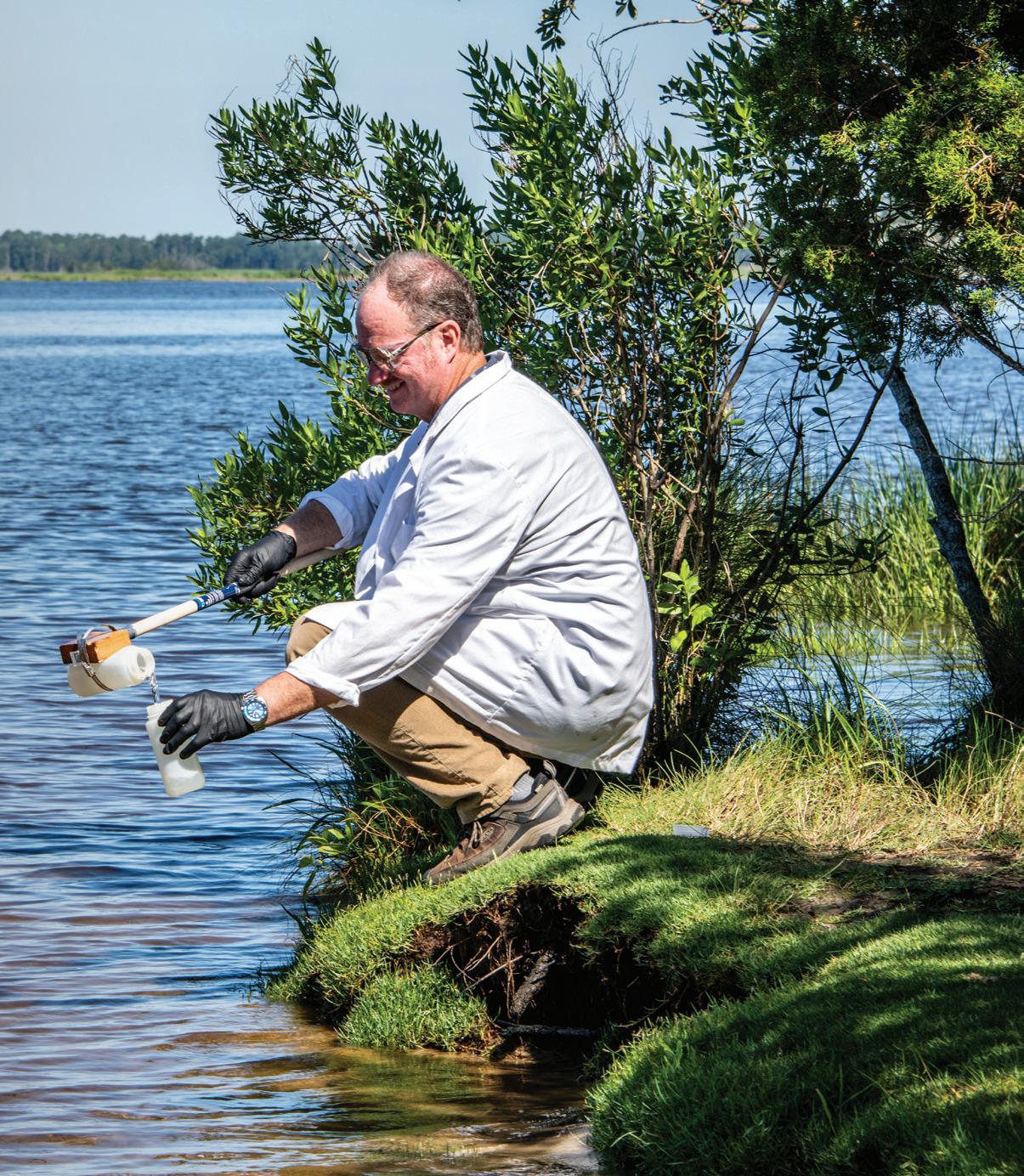



PULSE 2024
“The way our General Assembly’s made up right now that just was not something they wanted to champion and take on,” Donovan said, “so we focused on the federal level.”
About 100 miles upriver from Wilmington in Fayetteville, where PFAS originating from the Fayetteville Works plant ended up in the Cape Fear River, EPA Administrator Michael Regan announced this spring that the organization would enforce a new standard for the chemicals.
New drinking water standards were a piece of the Biden Administration’s government-wide plan launched in 2021 to mitigate PFAS pollution. The EPA plans to add nearly $1 billion to its $9 billion in funding to help affected areas test and treat contaminated water.
Granular activated carbon (GAC) filters at CFPUA’s Sweeney Water Treatment Plant keep the service’s water below the EPA’s newly specified PFAS levels, according to CFPUA officials.
Brunswick County is currently installing a reverse osmosis filter at one of its public water treatment facilities.
The reverse osmosis filter in Brunswick County’s Northwest Water Treatment Plant is 78% done, with an expected completion timeline of late 2024, according to Brunswick County officials.
Pender County Utilities uses sedimentation basins, sand filters and GAC vessels to keep the drinking water in line with EPA regulations, according to Pender County officials. The county is also planning a pilot study on PFAS “removal media,” officials said.
Until every public utility company catches up to the new PFAS standards, 3.4 million North Carolinians are drinking water with PFAS levels above the newly issued federal standards, said Elizabeth Biser, secretary of the N.C. Department of Environmental Quality.
Public water systems have three years to complete initial monitoring of PFAS and five years to implement solutions to reduce PFAS in drinking
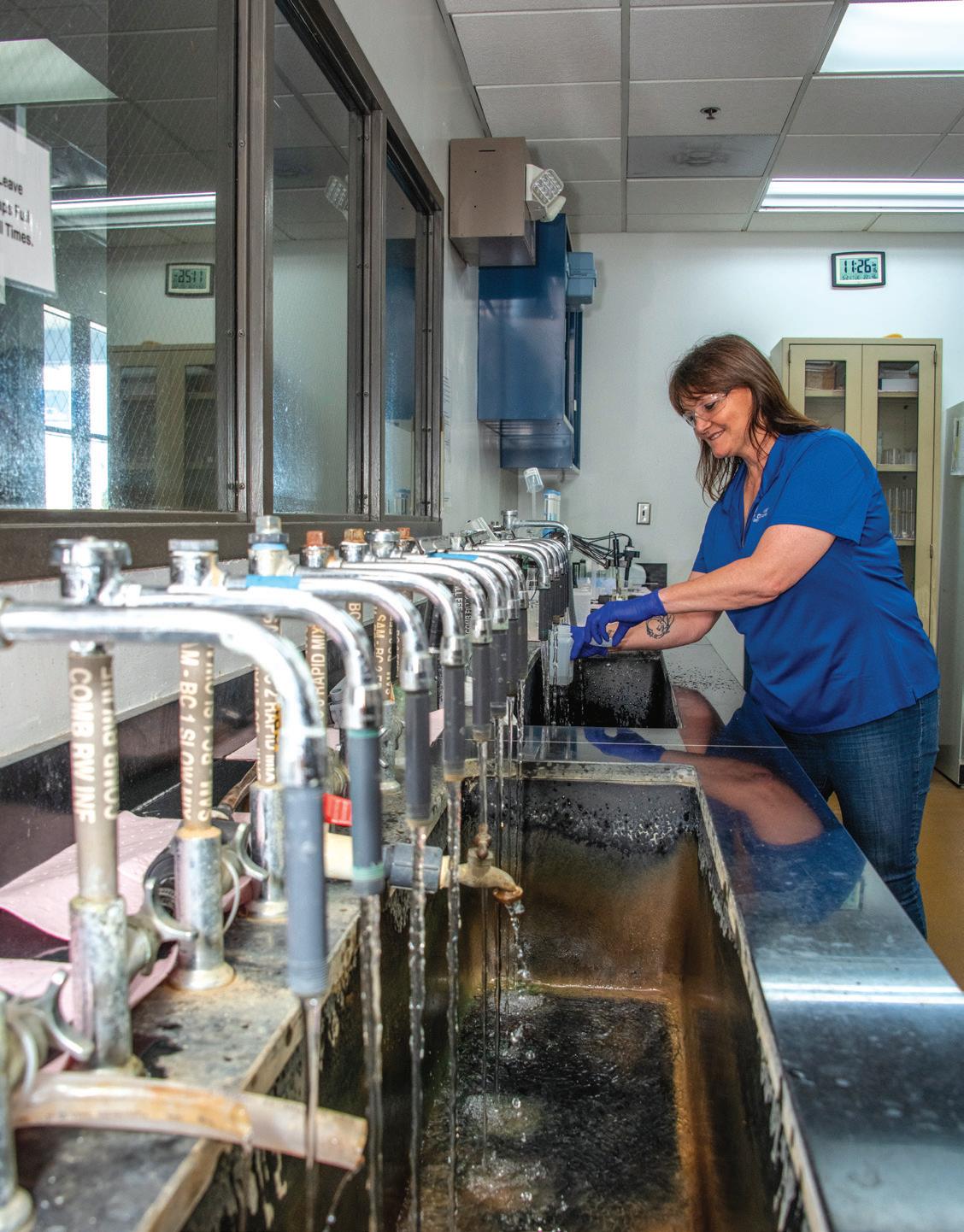
water if they exceed the federal standards before they could face infractions.
Meanwhile at the state level, Biser and her organization are beginning to call for separate rulemaking to reduce PFAS in groundwater and standing water now that the federal government issued a standard for drinking water.
This would force manufacturers that produce PFAS to reduce the polluted runoff entering bodies of water like the Cape Fear River, therefore lessening the burden on public utilities filtering out PFAS before it gets to the public.
The state proposals have received some pushback from state business leaders requesting a delay in rulemaking.
N.C. Chamber President and CEO Gary Salamido addressed a letter to Biser on behalf of the organization on April 22, requesting that NCDEQ halt its groundwater PFAS standards process until more research can be done on the fiscal repercussions for businesses.
Biser stated in a response letter the rulemaking process includes an analysis of the regulation’s impact on the state’s businesses, as well as costs and benefits resulting from the standards. She also noted the fiscal repercussions that public utilities have already had to undergo to place water filters in treatment plants, such as CFPUA’s and Brunswick County’s projects.
“If folks are putting PFAS into our surface waters and not having to clean it up and there are no standards in place, then the entire burden of cleaning up PFAS pollution falls on ratepayers,” Biser said.
The state’s rulemaking process to place standards on groundwater and standing water could begin in July, Biser said. She said the rulemaking process has the opportunity for stakeholder input, public comment
and public hearings to learn more and ask questions.
The N.C. Chamber issued a statement following Salamido’s and Biser’s exchange.
“The NC Chamber engages in a transparent and open process with government when advocating for certainty and predictability for North Carolina’s business community,” it read. “The business community has every right to ask questions and understand the consequences of proposed regulations.”
Wilmington, being a focal point for PFAS impacts, has turned into a focal point for PFAS research as well.
The PFAS Testing Network, headquartered at the University of North Carolina Wilmington, is a collaborative statewide study among higher education researchers started in 2018.
Ralph Mead, a chemistry and biochemistry professor at UNCW, is a member of the PFAS Testing Network. His team of student researchers was included in a $3 million investment from the N.C. Collaboratory, announced in March.
Mead’s lab received a Thermo Fisher Scientific Mass Spectrometer. The instrument will allow Mead’s team to develop and refine a forensic isotope tool to trace PFAS.
In simple terms, the instrument could allow the UNCW researchers to trace one PFAS compound back to its source. The tool is to help regulators identify potential sources of PFAS that were previously untraceable.
“As best as we can tell, no one has applied stable isotope forensic analysis to follow PFAS, and so everything we do on the instrument is going to be new,” Mead said. “The payoff is, we’re hoping anyway, going to be pretty big.”
While Mead’s team hopes to pioneer PFAS tracing technologies, a University of North Carolina at Chapel Hill-based project called NC
Pure is conducting a pilot program at CFPUA’s Sweeney and Richardson water treatment plants, testing a “novel sorbent,” or PFAS-specific filtration device.
UNC-Chapel Hill chemistry associate professor Frank Leibfarth leads NC Pure, a group working to create a material that selectively removes PFAS from water. While GAC and reverse osmosis filters were made to take all contaminants out of the water, NC Pure’s innovation is a sorbent, or an insoluble absorbing material, that targets PFAS specifically.
Currently testing at the two CFPUA water treatment plants with General Assembly funding granted in 2022, NC Pure plans to establish a third test site at a Triangle-area wastewater treatment plant soon, Leibfarth said.
“We have a lot of industry in our state,” Biser said. “There’s a lot of manufacturing, and with that, if you’re using contaminants as part of your process, and it’s being discharged we’re going to see higher levels (of contaminants in water.)”
North Carolina has heightened levels of both PFAS and another possible carcinogen, a chemical called 1,4-dioxane, in the Cape Fear River Basin.
The chemical is a clear liquid used as a solvent in some manufacturing processes. An EPA sampling program found that North Carolina has the thirdhighest measured concentration of the chemical in drinking water nationwide and fourth highest in the number of impacted drinking water systems, with most detections in the Cape Fear River Basin, according to the DEQ’s Human Health Risk Assessment.
The chemical can be filtered out of water systems using the same methods as filtering out PFAS, GAC and reverse osmosis filters, Biser said.



President Joe Biden speaks at the Wilmington Convention Center in May addressing funding to replace lead pipes nationwide.

“CFPUA’s Sweeney Water Treatment Plant is one of the few in the state that is equipped to treat 1,4-dioxane,” said Vaughn Hagerty, CFPUA’s public information officer.
Biser said that, in her role, she also hears from residents who are concerned about 1,4-dioxane as well as PFAS.
“And I have heard a lot of stories, both on this and PFAS,” she said, “of residents who will tell me, ‘I’ll drive you down this road and show you all the people who have died of cancer. What is going on?’ And they want to see us take action.”
While contaminants in the region’s water have made national headlines, a recent Biden administration initiative addresses aging pipe infrastructure.
Biden chose Wilmington to make his announcement in early May, unveiling a $3 billion federal investment to replace toxic lead pipes and deliver clean drinking water to communities nationwide, according to a White House release, with $76 million allotted to North Carolina.
“Today, 9 million lead service lines connect water mains to
our homes, schools, day care centers, businesses,” Biden said to an audience at the Wilmington Convention Center. “That includes some 300,000 lead service lines here in North Carolina alone – 300,000.”
When the subject of Biden’s visit to the Port City was announced, CFPUA officials issued a release assuring the public that there are no lead-polluted water mains in CFPUA’s distribution system.
CFPUA surveyors did not find lead service lines, according to CFPUA, however, they did find galvanized pipes, an older style of service line that could have a pipe connector made of lead. CFPUA plans to replace any galvanized pipes of lead pipe connectors, officials stated.
The surveying began in 2020, according to CFPUA officials. The organization’s jump on addressing the aging infrastructure in recent years helped the organization secure nearly $4.2 million in funds from the Bipartisan Infrastructure Law, enacted in 2021. This funding is in addition to the funds CFPUA plans to apply for from the announced $76 million.
CFPUA will not be doing any more service line replacements until at least the fall, officials said.


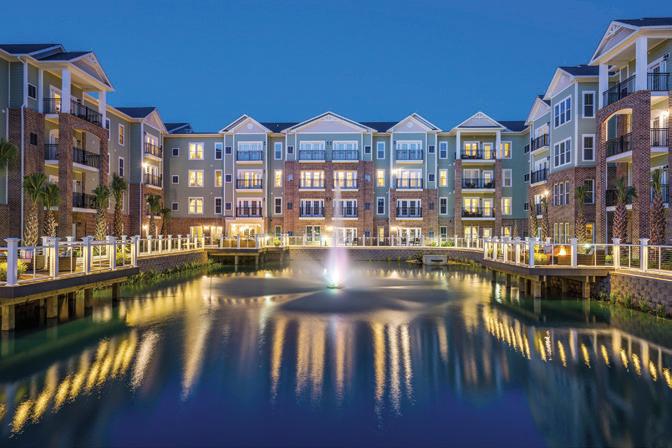





Wilmington loves our parks and city teams work hard to ensure residents can enjoy the beautiful spaces in our community.
From the recent opening of the eight reconstructed tennis courts at Althea Gibson Tennis Complex to the addition of an inclusive playground at Maides Park, investing in park improvements continues to be a top priority.
Master plans for parks and recreation, urban forestry, Greenfield Lake, and the Riverwalk all help to guide the city’s efforts to enhance Wilmington’s parks and outdoor spaces for today and into the future.




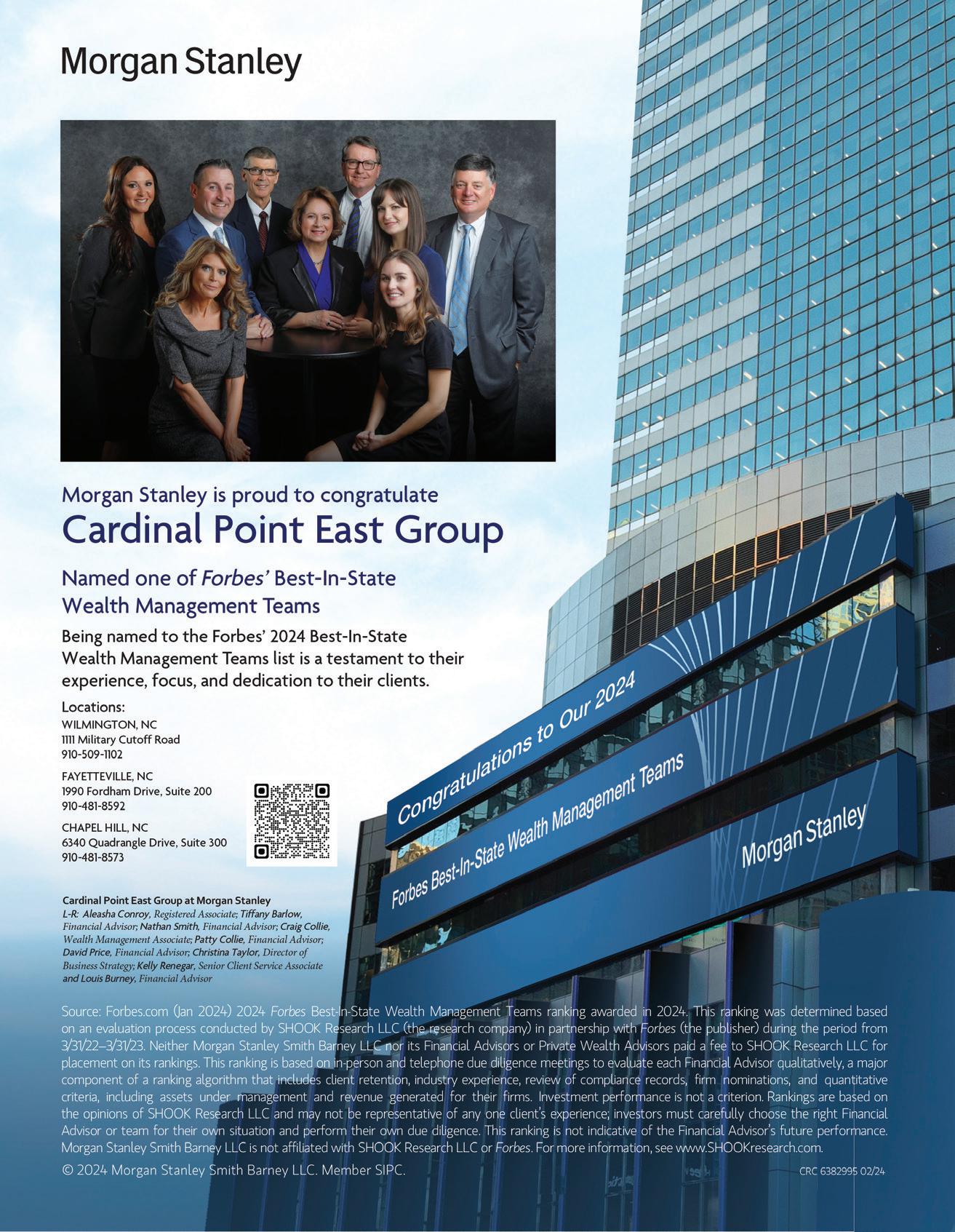


P ublisher
Rob Kaiser
rkaiser@wilmingtonbiz.com
P resident
Robert Preville rpreville@wilmingtonbiz.com
e ditor
Vicky Janowski vjanowski@wilmingtonbiz.com
M anaging e ditor
Cece Nunn cnunn@wilmingtonbiz.com
r e P orters
Emma Dill edill@wilmingtonbiz.com
Audrey Elsberry aelsberry@wilmingtonbiz.com
V ice P resident of s ales & M arketing
Angela Conicelli aconicelli@wilmingtonbiz.com
s enior M arketing c onsultants
Maggi Apel
Craig Snow
M arketing c onsultants
Alexis Alphin
Jillian Hon
d igital c lient success c oordinator
Jessie Vincoli jessie@wb360marketing.com
e V ents d irector
Jamie Merrill jmerrill@wilmingtonbiz.com
e V ents & M arketing c oordinator
Alecia Hall ahall@wilmingtonbiz.com
a rt d irector - e ditorial
Suzi Drake art@wilmingtonbiz.com
a rt d irector - M arketing
Tara Weymouth tweymouth@wilmingtonbiz.com
M edia c oordinator
Julia Jones jjones@wilmingtonbiz.com
d irector of f east W il M ington
Jessica Maurer jmaurer@wilmingtonbiz.com
c ontributing P hotogra P hers
Logan Burke, Megan Deitz, Madeline Gray, Aris Harding, Terah Hoobler
s ubscribe
To subscribe to WilmingtonBiz Magazine,visit wilmingtonbiz.com/subscribe or call 343-8600 x201. © 2024 SAJ Media LLC
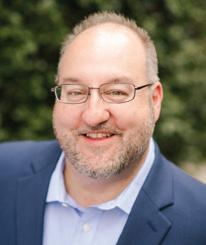

“Liberty Senior Living is excited to once again sponsor ‘The Good Life’ – A Guide to Retirement Living in Coastal North Carolina. For almost 150 years, Liberty Healthcare Management, a Wilmington-based, familyowned organization, has been helping older adults manage their healthcare and residential needs. Our portfolio of communities throughout the Southeastern United States continues to grow as we expand our service offerings, which include communities for active adult living, independent living, assisted living, memory support and skilled nursing care. We have proudly served the Wilmington area for over 30 years and now have three communities to select from: Brightmore of Wilmington, Carolina Bay at Autumn Hall and our newest Active Adult Community, Inspire Brunswick Forest. We invite you to visit LibertySeniorLiving.com where you can learn more about all of our premier communities, which have been designed for active seniors who have high expectations for living life to the fullest and on their own terms. We look forward to welcoming you!”
Dean Dellaria / Corporate Director of Marketing and Sales / Liberty Senior Living
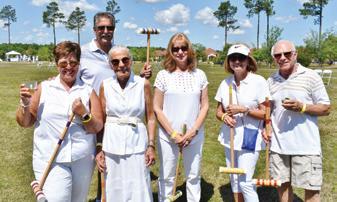
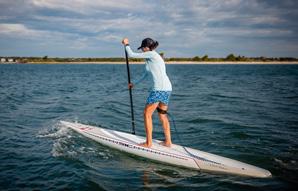





I’m not where you’re at, but I know how you got here.
The Wilmington Media + Marketing team has been hard at work in recent months to bring you this year’s Good Life Wilmington magazine, the annual publication for our features website on everything to help older adults make the most of Southeastern North Carolina.
Reading about the sheer number and fun topics of social clubs in the area for retirees – from bocce to bourbon – makes me want to start a countdown calendar for wrapping up the 9-5.
But I still have some time left to log.
That doesn’t mean I can’t relate to what brought you here – or if you’re reading this from afar and wondering where to set down roots for your next act.
More than a decade ago, I was working and living in downtown Atlanta, enjoying all the perks of largecity life but grumbling every time Interstate 85 crawled with traffic. My (later to become) husband is the beach bum at heart and said let’s make the move to the coast, any coast.
I checked out several, and for various reasons, coastal Carolina became our top pick – probably for many of the same reasons you had for relocating or staying here.
There’s the beaches and waves minutes away. Yes, many minutes in the crush of the summer, but still more accessible than having to drive from Raleigh to spend the day on the sand.
There’s the vibrant, nonbeach culture: art and restaurants downtown, entertainment in midtown, increasing options in Brunswick and Pender counties. I know people who fill their after-hours and weekends without even venturing to the beach towns.
There’s no shortage of sports and activities to get into, regardless of age group. (I just got word about pickleball clubs this summer starting at age 5,
so thanks for bringing that to us, Good Lifers.)
People by and large are friendly, and I’ve struck up plenty of conversations with strangers.
It’s a big enough city without being lost in a big city.
So whether you’re new to the area or been here for years and enjoy discovering new gems, dive into the issue. Here’s a sampling of what you’ll find if you flip through these pages:
• Homes + Communities: Get an update on how the beach housing market is faring in “Beach Abodes,” page 60.
• Health + Wellness: For those living in south Brunswick County, medical options are about to expand with Dosher Memorial Hospital’s next phase of growth. See how in “Dosher Hospital’s Growth Plan,” page 70.
• Lifestyles + Connections: Take advice from our Living Like a Local columnist Karen Bright about how to best navigate your days at the beach on page 78.
• Food + Drink: Did you move here from another state and sometimes miss the taste of home? There’s a chance your favorite regional dishes actually might be on local menus. Find some suggestions with “Flavor Profiles,” page 90.
And there’s plenty more where that came from on the Good Life Wilmington website (goodlifewilmington.com) and free weekly newsletter; the publication is primarily online to make it easier for people in our community and beyond to find information they need. Have a topic you want to see covered? Share your ideas with newsroom@ wilmingtonbiz.com.
Vicky Janowski, Editor Wilmington Media + Marketing vjanowski@wilmingtonbiz.com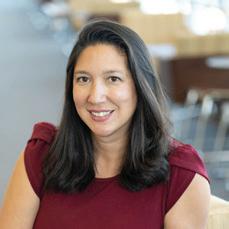








Photographer Madeline Gray covered

Barry and Ann Foster had just moved from Plano, Texas, on July 1 into their house in Brunswick Forest in Leland. Amidst myriad “getting settled” tasks, Barry Foster looked into whether the community had a bourbon club.
He first discovered a whiskey club in Wilmington with a $250 joining fee, on principle a nonstarter for him. He learned that Brunswick Forest had its own Bourbon Lovers Club and reached out for a conversation with the woman who headed it.
“I loved that she and her siblings were owners of the Old Pogue Distillery in Kentucky,” Barry Foster said. “She loved that I was very familiar with bourbon. I went to their first meeting – an unpretentious blind tasting – and she asked if I’d like to take over the club since they were about to move.”
He liked that it was “informal, friendly and inclusive.” He said yes and held his first club meeting, another blind tasting, in March.
Social clubs, whether formed by retirement communities of various descriptions or communities not formally defined as such and developments such as Brunswick Forest and Compass Pointe in Leland – whose age demographics skew older – these clubs are boons for building new “people connections.”
The Bourbon Lovers Club at Brunswick Forest, Barry Foster said, is committed to inclusivity, including respecting people’s choices. For certain, that relates to politics or lifestyle judgments, but also more subtle things.
“There was a lady there at the last meeting,” he said, “and I said I used to drink scotch, but I only drink bourbon now; she rightly objected. That extends to not disparaging someone’s brand, even accidentally. And we focus on making it cost-accessible for the widest possible audience.”
He spent roughly 10 years at Total Wine & More in Plano, enjoying his customer relationships, and continues part time at the Wilmington store.
“I also joined a bourbon club, Someone Say Whiskey, when it started in 2018,” he said. “By end of 2020 it was the nation’s fastestgrowing whiskey club, with 10,000 members.”

At Porters Neck Village in Wilmington, a casual observation by residents Jeanette Williams and Cheryl Jennings led to the formation of a fun and highly appreciated singles-directed club, Solo’s. They took up the idea with Porters Neck leaders, especially Living Well director Marci Sherman, and the idea morphed into a relaxed, low-pressure way for residents to meet and enjoy each other’s company.
“Aging in place with purpose and sense of connection is our aim,” Sherman said. “And resident-led clubs help us achieve that goal. Everyone’s different, and engaging our residents creatively is a key part of what we strive for.
“Jeanette and Cheryl had some great ideas about opening up the atmosphere so that people would feel at ease,” Sherman said, “and we facilitated that by reserving part of the dining room for monthly dinners.”
Sherman added that starting dinners off with a 5 p.m. happy hour at the facility’s bar may be a magic sauce helping club members to mingle and meet. They’re just beginning to talk about venturing out to different Wilmington locales.
Sherman conveyed that their new Ice Cream Club is “slightly kooky and totally loved by residents. The club started in November with seven members and now has 24. Hop on the bus and go eat ice cream – how can





you beat that?”
Compass Pointe in Leland has roughly 34 clubs that span virtually every interest and avocation. With the volume of Northeast transplants to the Wilmington region, it may not be surprising that bocce is one of those clubs. The club has grown from 75 initial members to 325, and usually, a quarter to a third of them turn out for Sunday afternoon tournaments on the community’s Great Lawn.
As the Compass Pointe website cheekily proclaims, “It has been documented that Bocce was once played in Ancient Rome. It is now played at Compass Pointe.”
Jumpstarted by a couple of exJerseyans and then strongly aided by a large team of fellow volunteers, The Bocce Club started in 2017. Mike Luciano moved with wife, Cyndi, from Lodi, New Jersey, to Compass Pointe in 2016. He quickly informed new friend Ken Clark that the community needed a bocce club.
Clark responded by introducing Mike Luciano to Kathy Grimaldi (she and husband, Joe, former East Brunswick, New Jersey, residents), who’d shown similar interest. “We learned we had to craft a charter,” Mike Luciano said, “so we did one. We designed it so the matches were very social and slightly competitive.”
The matches are well-organized, and the 20 courts accommodating eight players per court accurately measured, a contrast to Mike Luciano’s early bocce
experiences at his grandfather’s house in Lodi where distances were measured with sticks – wine and Italian food a given for them.
Matches are single elimination. Sunday afternoon signup starts at 1:30 p.m., and games begin promptly at 2 p.m. The final two teams, with four players each, are guaranteed a bottle of wine and week-long bragging rights. The year is broken down into two seasons, allowing breaks for extreme summer heat and colder winter weather.
“Our season culminates with our annual club dinner and tournament right around Columbus Day,” Mike Luciano said. “We have a beautiful group of people who put all of this together each week and a great executive board meeting twice a year at Cousins Italian Deli in Wilmington to plan – and enjoy wine, food and friendship.”
For Mike Luciano, the best thing about the club is the way they open bocce to many residents who have physical limitations.
“Here they can participate from their walkers or however, laugh and joke, and yes, sometimes get that winner’s bottle of wine,” said an appreciative Mike Luciano.
Lily Poulos, life enrichment assistant at Carolina Bay at Autumn Hall in Wilmington, saw that arts and crafts dominated most of the community’s programming. She thought there was room for a fun
science club, having recently studied exercise science and public health at the University of North Carolina Wilmington and learning the interests of residents. So, she began hosting a bimonthly laboratory class in January, a club, called “In the Lab with Lil.”
She emphasized that a number of residents have professional or teaching backgrounds in science and engineering.
“I have a strong background in the sciences,” Poulos said, “but so do they, so I knew I might politely be corrected. My broader goal was to give everyone a chance to re-experience science and make new friends.”
Poulos’s first lab was a seasonally appropriate exploding snowman, meaning that participants had to wear goggles.
“They loved that, and we also did a cool activity that involved inflating a balloon without air. And we had to do an exploding egg,” she said. “Soon, we’re going to tackle an ‘edible’ project, making ice cream in a bag. So far, the most common reaction is delight and laughter.”
If there is a humanity-based throughline connecting these disparate clubs, it might be represented by a quote from legendary distillery tour guide Freddie Johnson: “It’s not about the whiskey. It’s about the lives you touch and the people you meet. The whiskey is a byproduct of a good relationship.”
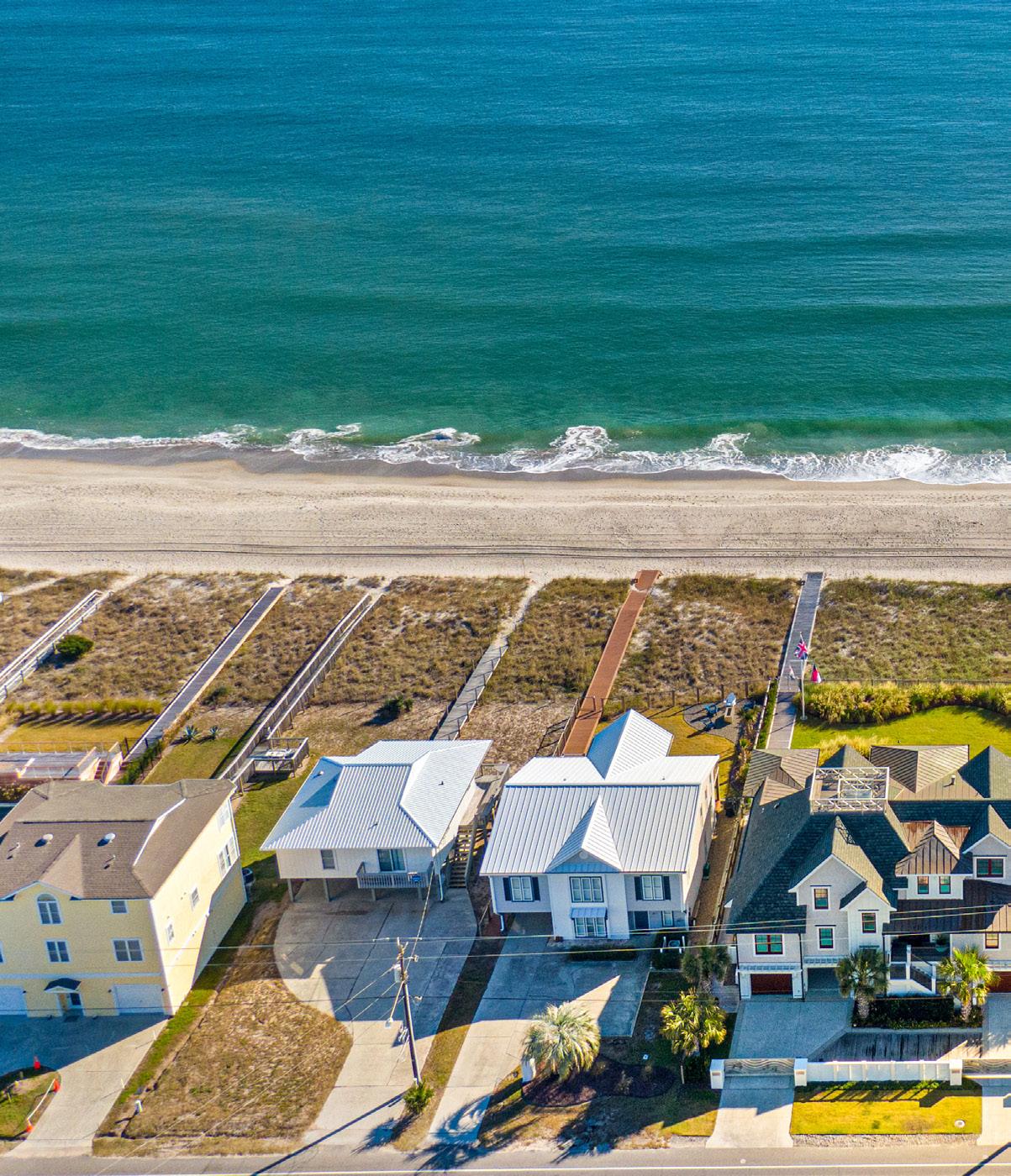
The real estate industry in the region’s beach towns surfs a changing market
Builders approached beachfront construction a little differently back in the day.
“The idea behind building a beach house was to not invest heavily in its construction, understanding that storms could easily destroy it. The intention was not to create the best-built structures since you didn’t want to have a significant amount of money tied up in something that might be taken down by a storm,” said Mark Batson, a Wilmington custom homebuilder specializing in luxury houses, including oceanfront properties. “Consequently, many of the homes we’re demolishing today, some of which are barely 30 years old, were never meant to endure. They’re simply falling apart.”
Batson, who owns Wilmingtonbased Tongue & Groove Design + Build, said he approaches building oceanfront homes as structures that

will still exist in 100 to 200 years.
“These will last as long as they’re maintained. Our goal is to build houses that are worthy of preservation,” he said. “For the next generations that come along, I don’t want them walking into a Tongue & Groove house and wanting to tear it down. Instead, I want them to walk in and say, ‘OK, this is a good house. This is worthy of preservation.’”
While many oceanfront homeowners have the means to weather figurative and literal storms, facets of that ownership include rising prices, upkeep, storm threats, sea-level rise, insurance costs and the possibility that they might not be allowed to rebuild a destroyed house because of setback requirements.
The prices of oceanfront homes, particularly unique, contemporary properties, have increased in recent years. The buyers of the house at 10 Inlet Hook on Figure Eight Island set a record in 2023 when they paid $13 million for the property. The home was designed by architect David Lisle
and built in 2022 by Whit Honeycutt, of North State Custom Builders.
Ransom and Courtney Langford, of Connecticut, purchased the nearly 5,000-square-foot home on the private New Hanover County island from John and Rebekah McConnell, of Raleigh.
According to real estate agents, that’s the highest sum paid for a house in recorded history in New Hanover County.
John McConnell, of McConnell Golf, purchased the lot for the custom home for $1.5 million in 2020.
Buzzy Northen, of Wilmingtonbased Intracoastal Realty Corp., represented the buyers in the transaction, while Jo El Skipper, of Figure Eight Realty, represented the sellers.
Real estate agents say it’s important to put recent eight-figure oceanfront sales in perspective.
On Figure Eight Island and in Wrightsville Beach, homes selling for over $10 million “are all homes built in the last six years or homes with extremely rare features such as oversized lots,” said Trey Wallace,
7

These will last as long as they’re maintained. Our goal is to build houses that are worthy of preservation.
Mark Batson, custom home builder and owner of Tongue & Groove Design + Build

president of Intracoastal Realty, when the news broke about the $13 million deal. “While we have certainly seen a run-up in prices over the past three years, these new price thresholds are being met in combination with some of the first newly built ultra-luxury homes turning for the first time.”
Wallace pointed out that the home at 407 Bradley Creek Point, which sold for $5 million in November 2018, set a record.
“Only five years later, we are approaching new sales records of $13 million,” he said. “It is certainly an incredible new price scale for our region. There will be more sales like this, to be sure, but only the most ultra-luxurious and modern builds will be able to command these prices, in my opinion.”
Modern properties continue to reach new price heights. In Kure Beach, buyers this March paid $9.2 million for 901 Fort Fisher Blvd. – a record price for a home sale on Pleasure Island, which includes Kure and Carolina beaches.
The sale was for a double lot on the oceanfront holding a main house and guest house designed and built by Tongue & Groove.
Batson said both structures, built in 2021, have the same material palette, including cedar shingles and copper roofs, but they’re a little different architecturally.
Batson can understand the appeal of Pleasure Island, where he grew up working on his father’s fishing boat.
In a LinkedIn post accompanying Batson’s announcement about the 901 Fort Fisher Blvd. sale Batson wrote, “Witnessing the evolution of our island communities over the decades has been a journey laden with nostalgia, pride and a sense of accomplishment. The metamorphosis from simple seasonal retreats to vibrant, yearround communities is a testament to the resilience, innovation, and spirit of those who, like my family, have called these beaches home.”
Peter Sweyer, a Realtor with Berkshire Hathaway HomeServices Carolina Premier Properties, doesn’t live on the oceanfront but does live in Wrightsville Beach.
“There is something magical about hearing those waves at night or when it’s dark and having that kind of force of the ocean near you is very soothing and calming for some people,” he said.
Sweyer helped the previous owners sell the oceanfront home at 7 Cowrie Lane in Wrightsville Beach in December. He said the property was on the market for 100 days but attracted interest from seven qualified buyers. The first folks who looked at it ended up buying the home.
According to Sweyer, the 5,700-square-foot home sits on nearly an acre, one of the largest oceanfront lots in Wrightsville Beach. The home has five bedrooms, six-and-a-half bathrooms, an oceanfront pool and a four-car garage. The transaction marked the first time the home had been sold; the seller purchased it while it was under construction and used it as a second home for 19 years.
Entrepreneurs Travis and Heather Sherry, who previously kept a home base in Pennsylvania, knew the risks and costs when they bought an oceanfront home in Carolina Beach during the pandemic.
They decided they could handle any issues that might come up.
“It feels like our own paradise here,” Travis Sherry said.
The couple bought the house at 1708 Carolina Beach Ave. N., within walking distance of Freeman Park, for $639,000 in August 2020. The 2,500-square-foot home feels like a beach bungalow.
“We’ve always really loved being near the water and going to the ocean,” Heather Sherry said. “And so, when we talked at length for years about our ideal place to live, it was always the beach.”
They wanted a house priced under $1 million and could be flexible with a location because they worked remotely before the pandemic began in March 2020.
“We had never actually been here or even heard of Carolina Beach or knew anyone here,” Travis Sherry said. “I was looking at real estate, and Carolina Beach was one of the more affordable places up and down the coast.”
The day they closed on the house in 2020, Hurricane Isaias was bearing down on the East Coast.
“We’re signing the papers at the lawyer’s office, and they’re like, ‘You’ve got to run over to town hall immediately because they’re closing at noon … and you need to get a re-entry decal because a hurricane is coming,’” Travis Sherry recalled.
Without the decal, it would be difficult to return to Pleasure Island after the storm if officials issued a mandatory evacuation order.
They lost power in the middle of the night, but crews restored it by 10 a.m.
“We had a few shingles missing from the roof, and that was it,” Travis Sherry said.
The couple is still able to get homeowners insurance on the property. For Carolina Beach, the N.C. Rate Bureau has requested a 99.4% increase in insurance rates for the beach areas of New Hanover – which includes Carolina, Kure and Wrightsville beaches – Brunswick, Pender, Onslow and Carteret counties. The state’s insurance commissioner has rejected the rate hike, and as of press time, a hearing on the request was scheduled for October.
Travis Sherry said no homeowner wants an increase, although the couple feels they can cover one.
“But at the same time,” he said, “I also feel fortunate that what’s happening in California and specifically Florida isn’t happening here where insurance companies are just pulling out completely, and you can’t get insurance.”
This story originally appeared in the WilmingtonBiz Magazine’s annual Residential Real Estate issue. Greater Wilmington Business Journal subscribers receive the quarterly WilmingtonBiz Magazine. To subscribe, go to wilmingtonbiz. com/subscribe.

Good Life Wilmington’s sister publication, the Greater Wilmington Business Journal, publishes an annual list of local assisted living and independent living facilities. The list is based on voluntary surveys sent to facilities in New Hanover, Brunswick and Pender counties.
Places that do not submit answers aren’t included, so this is not a comprehensive list below, but it does include details about many of the region’s options.
The list is ranked and listed in order below by the number of residents at each facility as of November 2023. The Business Journal will publish an updated list in December and in its annual Book on Business publication.
For more info, email editor@wilmingtonbiz.com.
Porters Neck Village
1200 Porters Neck, Wilmington, NC 28411 | (910) 686-7181 portersneckvillage.org
No. of residents: 290
No. of units: 264
No. of full-time employees: 145
Type of residents accepted: independent Services offered : fine dining; meal delivery service; leisure and concierge services; regular housekeeping and linen service; 24hour security staff; transportation to shopping, grocery stores and doctor appointments; a 24-hour Resident Care Center & Licensed Home Care Agency; fitness center with indoor pool, salon services, community auditorium; and more Year founded: 1988
Carolina Bay at Autumn Hall
630 Carolina Bay Drive, Wilmington, NC 28403 | (866) 455-0599 carolinabayatautumnhall.com
No. of residents: 275
No. of units: 146
Type of residents accepted: independent living, assisted living, memory care and rehab Services offered: planned continuing care retirement community with flexible meal options, 24-hour emergency response, weekly maid service, on-site health care and rehab, life enrichment programs, wellness center, scheduled transportation and spa/salon Year founded: 2015
Cambridge Village
75 Cavalier Drive, Wilmington, NC 28405 | (910) 239-9500
CVSliving.com
No. of residents: 260
No. of units: 220
No. of full-time employees: 65
Type of residents accepted: active adults 55+ who want to maintain an independent lifestyle with conveniences such as Mayfaire and an on-site Wellness Center Services offered: hybrid senior living community; resort-style rental; flexible dining program with restaurant, pub, smoothie bar, cafe, bistro and room service; salon and spa; housekeeping, transportation, Wi-Fi, 15,000-square-foot fitness center; heated saltwater pool and hot tub; studio, one- and twobedroom apartments with stainless steel appliances and washer and dryer in unit Year founded: 2015
I nspire at Brunswick Forest 6146 Liberty Hall Drive, Leland, NC 28451| (910) 239-2605 inspirebrunswickforest.com
No. of residents: 226
No. of units: 174
No. of full-time employee s: 6
Type of residents accepted: active adult seniors looking for a rental model independent living option Services offered: Year founded: 2023
Glenmeade Village Apartments 1518 Village Drive, Wilmington,
NC 28401 | (910) 762-8108 glenmeadevillage.com
No. of residents: 168
No. of units: 104
No. of full-time employees: 3
Type of residents accepted: all, 80% of residents are 55 and older Services offered: 24-hour emergency maintenance, indoor heated pool, tennis court, dog park, garden, book exchange, socials Year founded: 1969
Champions Assisted Living at Davis Community 1007 Porters Neck Road, Wilmington, NC 28411 | ( 910) 6866462 | thedaviscommunity.org
No. of residents: 148
No. of units: 123
No. of full-time employees: 100
Type of residents accepted: offers assisted living and memory care to seniors in a community environment with the look and feel of home; campus offers a continuum of care Services offered: continuum of care in an all-inclusive community that includes private suites and private bathrooms, personal care, medication administration, 24hour nursing professionals, meals and snacks, housekeeping, laundry services, medical transportation, activities, church services and wine socials, membership to Wellness Pavilion, Wi-Fi and DIRECTV Year founded: 2000
Brightmore of Wilmington Independent Living 2324 S. 41st St., Wilmington,
NC 28403 | (910) 350-1980
brightmoreofwilmington.com
No. of residents: 134
No. of unit s: 137
No. of full-time employees: 18
Type of residents accepted: seniors who desire a community atmosphere offering 24-hour security with other amenities and nonmedical services as well as access to additional services if or when needed Services offered: rental retirement living with studio, one- and twobedroom apartments with full kitchens and porches; monthly fee includes utilities, cable, Wi-Fi, chefprepared meals, housekeeping and flat linen service, emergency call, transportation and complete enrichment/wellness program with social activities and classes plus additional facilities and amenities Year founded: 1997
The Commons at Brightmore–Assisted Living & Memory Care 2320 S. 41st St., Wilmington,
NC 28403 |(910) 335-2945
brightmoreofwilmington.com
No. of residents: 96
No. of full-time employees: 86
Type of residents accepted: residents who need more moderate to substantial assistance with activities of daily living Services offered: hands-on personal care for individuals who are medically stable but need help with meals, bathing, grooming and medication administration and management; transportation;24hour staff, daily housekeeping and laundry service, three meals per day and snacks, beauty/barber shop, social activities; secure memory support area with an enclosed safe courtyard; on-site therapy with gym and services Year founded: 2003
Bradley Creek Health Care
740 Diamond Shoals Road, Wilmington, NC 28403 | (910) 335-4263
Carolinabayatautumnhall.com
No. of residents: 70
No. of units: 70
Type of residents accepted: residents that require individualized assistance with daily living, memory support, rehabilitation or skilled nursing Services offered: assisted living, memory support, rehabilitation, skilled nursing Year founded: 2015
The Kempton at Brightmore 2298 S. 41st St., Wilmington, NC 28403 | (910) 332-6899 brightmoreofwilmington.com
No. of residents: 57
No. of units: 62
No. of full-time employees: 27
Type of residents accepted: assisted living levels 1-3 with mild to moderate needs for assistance Services offered: assisted living and Alzheimer’s care to individuals with mild to moderate needs in private apartments Year founded: 2003




Liberty Senior Living offers seniors a nurturing environment where they can thrive with dignity and comfort. With a focus on holistic well-being and compassionate care, residents enjoy a variety of amenities and activities designed to promote physical, emotional, and social wellness. From independent living to assisted living and memory care, Liberty provides personalized support tailored to meet each individual’s needs, fostering a sense of community and connection that enriches the lives of all who call it home.
Liberty Senior Living is the development and operations management company for Liberty Healthcare’s senior living division. Located in Wilmington, this family-owned company has been helping people manage their healthcare and residential needs for more than 145 years.
The company founders, who opened their first pharmacy in 1875, established Liberty’s core values of quality, honesty and integrity that still guide them to this day.
We recognize that each person has unique preferences, lifestyle wishes and needs which is why we offer many options for older adults. For more than 30 years Liberty Senior Living, has been offering seniors personalized care in luxury communities built in some of the most desirable locations in the Southeast. With two locations here in Wilmington, Carolina Bay at Autumn Bay and Brightmore of Wilmington which includes The Kempton and The Commons on the Brightmore campus.
Among the top values of Liberty Senior Living communities is the desire to assist resident

members in achieving their optimal level of health. Wellness is more than an absence of disease; rather, it is an overall sense of well-being in many dimensions of one’s health including physical, nutritional, spiritual, social, and intellectual. With a focus on enriching these areas of our resident member’s dimensions of wellness, Liberty Senior Living and its communities embrace the INSPIRE wellness program. Moreover, Liberty’s dining experience is not just about nourishment; it’s a culinary journey that emphasizes fresh, locally sourced ingredients and diverse menu options to tantalize the taste buds and promote overall well-being.
Loneliness and isolation are prevalent issues among seniors, but Liberty Senior Living strives to combat these challenges by fostering a sense of community and connection. A vibrant social calendar encourages residents to forge meaningful relationships, participate in group activities, and contribute to the community in various ways. Whether it’s joining a book club, volunteering for a local cause, or simply enjoying a chat with neighbors over coffee, residents at Liberty always find opportunities to connect and thrive.
In an ever-evolving landscape, Liberty Senior Living
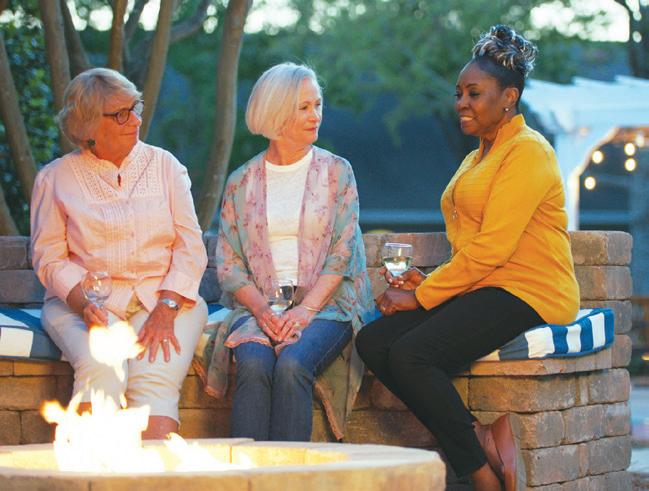
remains at the forefront of innovation and best practices in senior living. They continuously invest in staff training, technology, and infrastructure to enhance the resident experience and ensure the highest standards of care and safety. From state-ofthe-art wellness centers to our innovative memory care program (GEMMS), Liberty is committed to staying ahead of the curve and adapting to the changing needs of seniors.
With a legacy spanning decades, Liberty Senior Living has earned the trust and admiration of residents, families, and industry professionals alike. Their unwavering commitment to excellence, integrity, and compassion has solidified their position as a leader in senior living. Beyond providing exceptional care and services, Liberty is a place where seniors can truly thrive, celebrate life’s milestones, and make lasting memories in a supportive and enriching environment.
In conclusion, Liberty Senior Living is not just a place to live; it’s a lifestyle rooted in compassion, wellness, and community. By prioritizing individualized care, promoting wellness, fostering community, embracing innovation, and upholding a legacy of excellence, Liberty is redefining what it means to age gracefully and vibrantly. For seniors seeking a place to call home where their golden years can truly shine, Liberty Senior Living stands as a beacon of hope and possibility.


Brian Turner, project manager of Dosher Memorial Hospital’s new emergency department, and Lynda Stanley, the hospital’s president and CEO
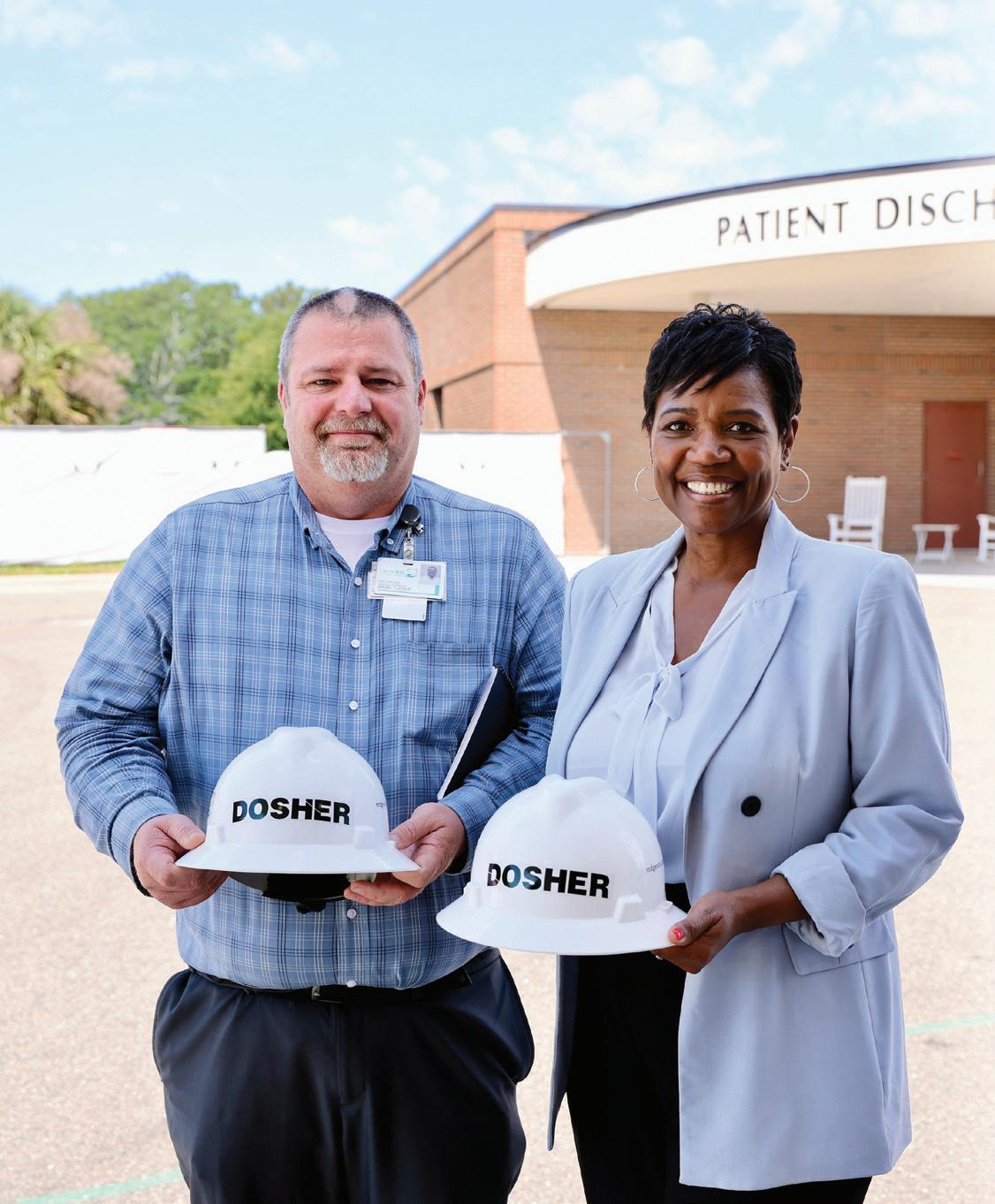
osher Memorial Hospital has long been committed to providing highquality medical care to its Brunswick County community. The hospital is currently undergoing significant expansion and renovation to ensure it can continue to meet the needs of the county’s burgeoning population now and in the future.
DWork is progressing on the hospital’s new emergency department building, located at the corner of East Ninth and North Howe streets, as well as the expansion of Dosher Memorial’s Oak Island clinic. The expansion of the Dosher Medical Plaza on Long Beach Road is already completed.
“These renovations are more than buildings,” said Lynda Stanley, the hospital’s president and CEO. “They represent our commitment to care for our local residents and to contributing to the health and wellbeing of our patients for years to come.”
The centerpiece of the Southport community hospital’s expansion is its new ED, which is designed to provide efficient patient care, according to Stanley. At 8,000 square feet, it is more than double the size of Dosher’s current ED and will include 14 patient bay areas, up from 10, as well as vertical chairs.
The use of vertical chairs is a relatively new practice in emergency departments. While patients with serious injuries or illnesses are assigned a bed, those with less acute medical issues, such as a fishhook in a finger, a fever or a sprained ankle, for example, are assigned a vertical chair. Also, patients who had been assigned a bed but are in that in-between stage of recovery – they have improved but aren’t yet well enough to be discharged – may be reassigned to a vertical chair.
These chairs, which resemble comfy reclining chairs, make the best use of space, streamline patient care and often shorten a patient’s stay in the hospital, according to hospital administrators.
“Many times, people will come in and they may not need a bed,” Stanley said. “It may be that we can meet their needs sitting in a chair –a very comfortable chair – that is well equipped. We can provide excellent care to them, but they don’t need to be in a bed.”
The new ED will also include its own X-ray, lab draw station and registration desk. It also will be outfitted with innovative technology such as teleneurology and telehealth. Robotic surgeries are an option for orthopedics patients as well.
The ED project is scheduled to be completed by the end of 2025.
The expansion of Dosher Memorial’s clinics is moving forward too. Three provider spaces have been added to the Dosher Medical Plaza clinic, and work at the Oak Island clinic, the addition of two provider spaces, is ongoing.
With these renovations, residents of all ages with all types of medical issues can more easily access medical services in this part of Brunswick County, according to Stanley. While those with serious medical problems, such as the elderly, will find the care they need at the ED, younger adults and children can visit the Dosher Memorial’s clinics for routine and less acute medical issues.
The driving force behind Dosher Memorial’s expansion is Brunswick County’s booming population growth. This past year, Brunswick County was the fastest-growing county in the state, according to Stanley. She added that projections put 65,000 new residents in the county by 2030 and that a significant portion of those residents will be older adults.
“We knew we needed to position ourselves to take care of this community as it grows,” Stanley said. “At least 65% of that population is on Medicare, and they need to be able to

get the care they need close to home. We want to provide emergency and regular care, and we needed to put the infrastructure in place to meet that need.”
To achieve that goal, hospital trustees and leadership developed a seven-year master facility management plan consisting of five phases. In addition to expanding the ED and Oak Island and Dosher Medical Plaza clinics, Phase 1 of the plan also includes increasing the size of the hospital’s pharmacy and lab.
Developing the facility plan entailed a concentrated effort by a team of professionals, including hospital board members, architects, designers, and staff. That collaboration led to better solutions for the hospital’s expansion, Stanley said.
For example, the team determined that a new ED was a better solution than renovating the current ED space. Building a new ED ensured that services for ED patients would continue uninterrupted, and the new space can be built out as the community continues to grow, she said.
“This was great work by the team,” Stanley noted. “They took their time in an ongoing process. With such due diligence, we recognized additional opportunities.”
So far Dosher Memorial’s renovations are meeting targeted timelines, and staff are doing everything possible to ensure they stay on schedule, Stanley said. For example, to avoid delays due to supply chain issues, essential materials such as steel are ordered far in advance, she explained.
Though the price tag for Phase 1 of the master facility plan was set at $15.4 million, Stanley said that with inflation, the cost could creep up to $16.6 million. The project is funded by an ad valorem tax paid by Smithville Township residents.
Despite its small size (the hospital boasts 25 beds), Dosher Memorial has earned a reputation for high-quality medical care. Its accolades include a Press Ganey HX Guardian of Excellence Award, which places Dosher Memorial in the top 5% of health care providers for patient experience in surgical care in the past year; a four-star rating on the Hospital Consumer Assessment of Healthcare Providers and Systems’ patient survey; and recognition for excellence in hip and knee orthopedic surgery and wound care.
Stanley said she regularly receives letters and other communications from grateful patients and family members about the compassionate care they receive.
“We have created a strategy around delivering world-class care in a small community hospital,” she said. “We are high tech and high touch. You can’t get any better than that.”
 by Madeline Gray
by Madeline Gray
ccompanied by his mother, Deloris Jordan, sports superstar Michael Jordan spoke in May about returning to the city of his youth to play a role in expanding health care in Wilmington.
Jordan visited Wilmington on May 7 to cut the
From Staff Reports
ribbon on the first of two medical clinics he’s helped fund in his hometown.
Novant Health announced in early 2021 that the Wilmington native and six-time NBA champion had donated $10 million to help open two Novant Health Michael Jordan Family Medical Clinics in New Hanover County.
Jordan has previously partnered with the health system to open two clinics in Charlotte.
The first clinic, at the corner of 15th and Greenfield streets, opened its doors in April, while site work has started on the second medical clinic near the corner of Princess Place Drive and North 30th Street, according to a Novant Health spokesperson.
More than 100 local leaders and other community members turned out for the ribbon-cutting. Jordan, his mother and other members of the Jordan family attended the event.
Ernie Bovio, president of Novant Health New Hanover Regional Medical Center, kicked off the event by thanking Michael Jordan for his investment in the clinic and the broader community.
“As you will soon see, this clinic is impressive. The care team, the physicians practicing here are committed and dedicated to transforming the way health care is experienced through this new community resource,” Bovio said. “And there’s no doubt that the clinic will be vital to the health of our friends and neighbors for many years to come, so thank you, Michael, for creating a healthier future, a brighter future for so many here in Wilmington.”
Addressing attendees, Michael Jordan said it was “good to be home.” He said he and his family want to continue giving back to the community, building on the clinic model established in Charlotte.
“We did it in Charlotte, and now we’re going to do it in Wilmington, which makes it even more special because this is home; this is where I came from,” he said. “No matter how you see Michael Jordan, this is where I started.”
Deloris Jordan reminded community members that they need to play an active role in supporting the new Wilmington clinic.
“With this building, you must contribute. He brought it, he established the partnership, but it’s for your benefit, not his,” she said. “One person can’t do it all; it has to be a team.”
Michael Jordan graduated from Laney High School in Wilmington in 1981, and in 1982, he helped lead UNC to a national championship. He went on to play 15 seasons in the NBA, winning six championships with the Chicago Bulls.
The first 7,800-square-foot medical office at 1423 Greenfield St. has 12 patient rooms and will offer comprehensive primary care services, including to those who are uninsured or underinsured, according to Novant Health.
Novant leaders worked with the local nonprofit Cape Fear Collective to identify locations with the greatest need for medical clinics. The clinics aim to make health care services more accessible, especially for underserved communities.
In July 2021, New Hanover County leaders transferred the 2 acres at the corner of 15th and Greenfield streets to Novant Health for the clinic’s construction. Crews broke ground on the project in October 2022.
Late last year, Michael Jordan and his family entered
into discussions about plans to bring a Jordan museum to Project Grace in downtown Wilmington. New Hanover County leaders recently announced that the family had opted not to move forward with the museum plans.
Wilmington Health’s Jayme Stokes this year successfully performed the first SADI-S procedure in the region, according to the practice.
Stokes, a board-certified general and bariatric surgeon, performed a Single Anastomosis Duodeno-Ileal Bypass with Sleeve Gastrectomy (SADI-S).
“SADI-S represents a significant advancement in bariatric surgery, offering patients a comprehensive solution for long-term weight management,” Stokes said in a news release.
The procedure requires making one intestinal bypass instead of two as part of the patient’s weight-loss surgery, “reducing surgical time and minimizing the risk of intestinal leakage.”
“The two-step laparoscopic surgery begins with the removal of a substantial portion of the stomach, transforming it into a slender ‘sleeve’ structure,” the release stated. “This sleeve restricts food intake and diminishes the production of the appetite-stimulating hormone ghrelin, aiding in appetite suppression.”
SADI-S was introduced in 2007 as a modification of the more traditional duodenal switch operation, officials said, adding that the procedure has shown enhanced outcomes and reduced postoperative complications.
“Unlike the duodenal switch, SADI-S preserves a greater portion of the intestine, enabling improved nutrient absorption and minimizing the need for lifelong supplementation,” the release stated. “Additionally, the single intestinal connection in SADI-S reduces the risk of leakage and future bowel obstruction, enhancing patient safety and long-term surgical success.”
“SADI-S represents a significant advancement in bariatric surgery,” Stokes said, “offering patients a comprehensive solution for long-term weight management.”
Novant Health adds new AFib treatment
Novant Health Heart & Vascular Institute has incorporated a recent FDA-approved treatment for AFib, or atrial fibrillation, as an option for local patients.
Pulsed Field Ablation (PFA), a technology created by Medtronic, involves using pulsed electrical fields sent through a catheter to treat misfiring cardiac tissue in the heart, according to a news release from the health system. The goal is to permanently correct a patient’s irregular heartbeat.
Novant Health providers did their first procedures with the technology April 3 at Novant Health New Hanover Medical Center and Novant Health Forsyth Medical Center in Winston-Salem.
“AFib causes symptoms and can increase risk of heart failure and stroke, so it’s important to identify and successfully treat the condition,” Bill Smith, clinical physician executive for Novant Health Heart & Vascular Institute in the health system’s coastal region, said in the release. “Launching this new treatment at two sites on the same day is a testament to a strong effort from across our Heart & Vascular Institute to offer the latest advanced treatment options to our patients.”
AFib, officials said, is the most common type of cardiac arrhythmia and a condition that is expected to affect more than 12 million people nationally by 2030.
Surgery center recognized by orthopedic organization
Brunswick Surgery Center this year received four certificates of excellence from accreditation organization DNV Healthcare, according to a news release.
The certificates were for four subspecialties that DNV surveys:
• advanced foot and ankle surgery
• advanced hip and knee replacement
• advanced shoulder surgery
• advanced spine surgery
Located in the EmergeOrtho building in the Villages at Brunswick Forest, Brunswick Surgery Center (BSC) is one of the region’s first outpatient ambulatory surgery centers dedicated to advanced orthopedics, the release stated. The center is staffed by 29 board-certified or board-eligible fellowship-trained surgeons from EmergeOrtho.
Because Brunswick Surgery Center achieved advanced certification in at least three orthopedic programs, it also obtained a DNV Orthopedic Center of Excellence designation, recognizing BSC as “a demonstrated leader in the safe delivery of orthopedic surgeries.”
According to the release, the DNV Orthopedic Center of Excellence designation is based on guidelines, recommendations and evidence-based, professionally recognized standards of practice acknowledged by leading professional organizations and agencies in the discipline. The designation is valid for a three-year term.
“I believe that the DNV certification reflects our efforts to support the vision and mindset of Brunswick Surgery Center,” Eric Lescault, a board-certified orthopedic surgeon at Brunswick Surgery Center specializing in joint replacement and sports medicine, stated in the release. “That has always been to offer the most technologically advanced, affordable orthopedic care to our region.”


In their retirement, Lisa Quigley and her greyhound, Bernie, have volunteered at area hospitals to cheer up patients and staff.By Amy Kilgore Mangus
I knew an hour into fostering Bernie that he wasn’t leaving,” Lisa Quigley said.
Bernie is a 7-year-old greyhound Quigley adopted from Greyhound Friends of North Carolina.
In their retirement – Bernie from the racetrack and Quigley as an echocardiographer in New York –the duo has volunteered at Novant Health New Hanover Medical Center and Novant Health Brunswick Medical Center for the past three years.
“Bernie has a calming personality,” Quigley said. “And I wanted to get back into the hospital. I feel comfortable in that environment. It’s like home to me.”
Quigley enrolled Bernie in Canine Good Citizen, a 10-skill test that teaches good manners to dogs and responsible dog ownership to their owners. Bernie progressed to the advanced level and tested to become a therapy dog.
Twice a week, the duo travels from Rocky Point to volunteer in the lobby, patient rooms, and waiting rooms.
Patients and employees are greeted as they come and go. And Bernie offers much-needed stress relief for medical students during
their lunch break.
“As I walk in, I hear ‘Bernie’s here!’ Quigley said.
Word spreads quickly that Bernie is on the hall.
“Bernie walks in, and the patients’ faces light up. It’s like the sun has come out, and they are just so happy,” Quigley said.
Being hospitalized can be isolating, particularly for those who don’t get many or any visitors.
“Some patients cry when they see Bernie,” Quigley said. “They hug, kiss and pet him. It means the world to them to interact with us. And for me, talking with patients was the best part about my job when I worked in a hospital.”
While many know their faces, many aren’t aware of the battle Quigley is facing behind closed doors.
She spends additional time at the hospital receiving treatment for cancer. But that hasn’t slowed her down.
“It was rough in the beginning,” Quigley said. “But after a couple treatments, I have a better command on things. We don’t miss any volunteer visits.”
It’s sometimes difficult, but Quigley said Bernie gives her a reason to wake up and leave the house.
“Bernie gets very excited when
I say we’re going to the hospital,” Quigley said. “The hospital has been very supportive and compassionate. It helps to have such a huge support system at both hospitals.”
Bernie accompanies Quigley to her treatments.
Quigley was recently recognized with a Guardian Angel pin for her volunteer work at Novant Health Brunswick Medical Center.
“That was a total shock,” she said. “I was honored, but a bit embarrassed because I’m sure other volunteers have contributed more.”
While Bernie is compensated with treats from the staff and an occasional pup cup from the Novant Health NHRMC Port City Java, Quigley says the joy of volunteering at a hospital is worth much more than goodies or a salary.
“Everyone should volunteer and know what it’s like to give your time and the happiness it can bring,” she said. “It’s a rewarding experience.”
Helping Hands is a recurring Good Life Wilmington feature that spotlights older adult volunteer across the Wilmington area. To recommend a volunteer or program, email editor@ wilmingtonbiz.com.

Whether it’s your first summer in the Cape Fear region or you’re a beach pro, we’ve got tips to make the most of your sandy outings in the months ahead. Longtime Wilmington resident Karen Bright writes a regular column for Good Life Wilmington called Living Like a Local to give you insider tips on the area.
Here’s a roundup of her beach recommendations, including a look at the ideal day by the waves to live vicariously through.
Are there better ways to spend the day than at the beach? You live in coastal North Carolina now so probably not. When you wake up in the morning you notice the sky is cloudless and Carolina blue. The weather promises to be a magnificent 85 degrees with some humidity. The humidity is just enough to keep the air warm with that slight, cushiony feel to prevent any chill from the ocean breeze. When you check, the tide will be low at 11 a.m. making for ideal conditions. Your husband may have plans to work around in the yard or fix something; you have another idea:


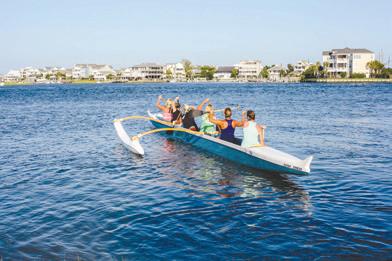
the beach. Convincing him is not difficult, after all, he is a born beach bum too. Maybe your 20s are long behind you but dropping all plans and heading to the beach is still in your bones. Together you pack up the Jeep and the gear.
You get towels, snacks, beach chairs and a tent for shade. You know from experience that large buckets filled with sand and tied to the legs prevent any potential drama from a tent launching down the beach in the breeze. You make a final check for sunscreen, hats and sunglasses.
Today you choose to drive onto the beach. Your husband loves the theatrics of bumping along in the sand and watching others get stuck. This doesn’t happen to you; you are pros. You like the drive onto the beach for the ease of unloading the supplies and the knowledge of an easy exit when the time is right.
When you find your favorite spot, you park your Jeep. You situate yourself for the idyllic photograph of Jeep, blue-green water and dunes in one photo. You post it to make every one of your friends who stayed in the North or are landlocked in cities jealous and to show off your good decisions.
You hop out of the vehicle, well maybe step out gingerly, unload and set up. The shade tent is first; your days of sun-worshipping are over. You are sensible now. The chairs are on the sand, the coolers are unloaded and cold drinks are in your hand.
Here comes the Kona Ice truck, and the kids on the sand lose their minds in a panic to get money from prepared parents. You smile as you watch the kids race

down the beach to catch him. They come back a flutter of happiness with small cups of frozen, sweet ice.
You and your husband give each other knowing looks and laugh as you remember when your own kids were that age. You feel very nostalgic, maybe a little tug at your heart. Then you remember your own grandkids will visit soon.
Immediately you are grateful for the easy day.
You and your husband decide to go for a walk. You collect seashells and people watch. When you glance out at the ocean there are dolphins. You’re sunkissed and tired – it’s time to break everything down and pack up the Jeep. You pack your shells into the beach bag because these will look great in a glass bowl at home.
The traffic is light as you drive off the beach. The ride home is glorious with no roof and doors and the wind in your hair.
Are there better ways to spend the day than at the beach? Maybe, but in coastal North Carolina, you think not.
Deciding which beach to set up camp at for the day, though, sometimes depends on what you feel like doing that day.
Wrightsville Beach will always have a special place in my heart. This is where I first stepped foot in North Carolina. I have lived here, I have worked here and I will always find time to relax here.
The south end of the beach is glorious because the Intracoastal Waterway meets the ocean and makes for

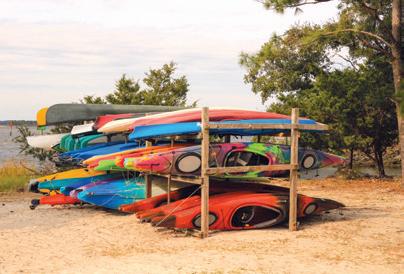

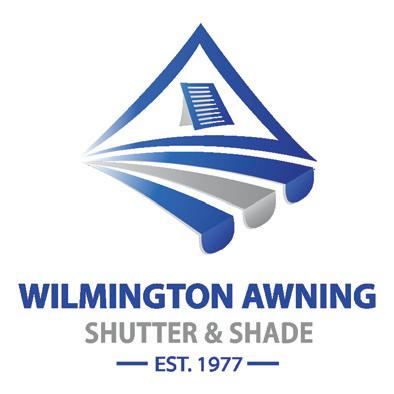


a calm swimming spot. If you choose to spend your time within the central part of the beach, you will have the added benefit of walking to many restaurants and shops.
The north end of the beach is great for walking and finding seashells. Wrightsville is the place to be in the off-season when the weather is warm, and the traffic has dwindled.
If you own a four-wheel drive vehicle, then I suggest the Fort Fisher State Recreation Area. This is where you will find the Basin (or Hermit) trailhead. To drive on the beach, you will need a pass. The visitor center is located to the immediate left of the beach entrance. You can purchase a day pass or season pass.
I personally like to go when the tide is low and the water tends to be a little calmer as this stretch of beach is not serviced by lifeguards. Too many people think they are immune to the dangers of the ocean and its waves. As a public service announcement, please know you are not.
Carolina Beach is another excellent option. It has restaurants, weekly live music and fireworks, a Ferris wheel, and so many other options along with sitting on the sand.
Although it is only a 40-minute drive, give or take, from Wilmington, Pender County beaches are worth the trip. We have been known to vacation at Topsail Island.
These beaches are great not only for the sandy beaches but for the piers – all three provide free parking and bathrooms. The fees for fishing and walking differ based on the pier. They also all have restaurants, shops and the ability to simply see the views.
Seaview Fishing Pier is the northernmost pier, in North Topsail Beach, then you come down to Surf City Ocean Pier, then finally the Jolly Roger Inn and Pier at Topsail Beach.
I find Pender County beaches to be less crowded than the beaches of New Hanover County in the summer, and even quieter in the off-season, if that’s what you’re after.

Retired Lt. Colonel Allen Lamb receives a lifetime achievement award for bravery and breaking new ground in aerial warfare
By Neil Cotiaux | Photo by Terah Hooblerfor the growing number of older adults who call coastal North Carolina home, retirement means lazy days at the beach, barbecues with family and friends and biking along an increasing number of walk-and-cycle trails.
For Allen Lamb, who is 72 and splits his time between his hometown of Lumberton and Wilmington’s Landfall community, retirement also means basking in the glow of a lifetime achievement award bestowed on him by fellow retirees of the U.S. Air Force for valor during the Viet nam War.
Called “Wild Weasels” because its tactics were reminiscent of the way a hunting ferret enters the den of its prey to kill it, the top-secret mission



that Lamb led in 1965 meant making the first flight of a fighter jet equipped with radar-seeking missiles to pinpoint incoming Soviet surface-toair missiles, or SAM(s). The ultimate objective? Neutralizing enemy launching pads on the ground.
“The task of a Wild Weasel aircraft is to bait enemy anti-aircraft defenses into targeting it with their radars, whereupon the radar waves are traced back to their source, allowing the Weasel or its teammates to precisely target it (SAM sites) for destruction,” according to Wikipedia.
“They’re (the Air Force) using the techniques that I developed … the Weasel became the tip of the spear. It really set the Russians back,” Lamb said in an interview following a May 3 tribute at Landfall Country Club. At the event, he was honored by representatives of The Society of Wild Weasels; his wife, Frances (shown with Lamb on previous page) ; and other friends and family in recognition of the groundbreaking missions that he flew.
“I was asked to volunteer” before he was briefed on what the Air Force had in mind, Lamb recalled. “I ended up getting the first three and the fifth one (SAM ‘kills’). We couldn’t even keep records of anything.”
Lamb’s leadership role in the Wild Weasels came at a time when the U.S. was losing planes in a bombing campaign over North Vietnam called Operation Rolling Thunder due to the effectiveness of Soviet SAM(s) in support of Ho Chi Minh, a communist who served as president of North Vietnam from 1945 to 1969. Based in Hanoi, he had plans to overtake U.S.backed South Vietnam.
After he died in office, the longrunning Vietnamese standoff as well as diminishing public support in the U.S. for the war led to a peace accord in 1973 and an uneasy unification of North and South. When Saigon fell, it was renamed Ho Chi Minh City.
Erica Mearns, Lamb’s daughter, grew up going to Air Force reunions with her father. She describes his initial Wild Weasels sorties as “a suicide mission.” Nevertheless, he flew a total of 298 Weasels flights, with a small Bible onboard and saying

a prayer before taking off.
“A Wild Weasel crewman wore a hard helmet and an oxygen mask with an integrated microphone. A survival vest held a first aid kit, escape map, survival kit and other items useful should he be shot down or forced to eject,” according to the National Museum of the U.S. Air Force website. “Over the waist and legs is a g-suit, which fills with air during sharp turns to keep him from passing out from high g (gravitational) forces. On his back is a parachute. Other items normally carried included a pistol and survival knife,” the web posting added.
Lamb was accompanied on his first Wild Weasels flight by Jack Donovan, a back-seat navigator.
“I couldn’t do what I did up-front without him … He was pointing out where the (Soviet) guns were coming from, (and) we could actually detect radar that was hitting us on the airplane,” Lamb said.
When Lamb was awarded the Silver Star for his leadership role in the Wild Weasels, he refused to accept it because Donovan was not also honored. Donovan, however, did receive the Distinguished Flying Cross for his actions. He died in 2015 at age 82 and was buried at Arlington National Cemetery.
In addition to introducing a new tactic in electronic warfare, Lamb was the only Weasel to regain flight status after ejecting from his jet, his
daughter noted, as well as the only military pilot at the time to regain that status. But he sustained three fractured vertebrae in his back and two in his neck.
“To regain flight status he had to do 100 jumping jacks, 100 situps and 100 pushups in 12 minutes,” which he mastered over six weeks, said Mearns, who also lives in Wilmington.
“From protecting his B-26 bomber as a tail gunner from Soviet MIG pilots over Korea, to being distinguished as the first American pilot to successfully destroy North Vietnamese surface-toair missile SAM sites in an F-100 Super Sabre fighter jet, Lieutenant Colonel Lamb’s Cold War service consisted of many hazardous and diverse assignments,” reads a statement from U.S. Senator Thom Tillis that was placed into the legislative record. “Although it is difficult to narrow all of the spectacular death-defying accomplishments of Lieutenant Colonel Lamb’s career down to one specific achievement, his participation in the first ‘Wild Weasel’ strike against a North Vietnamese SA-2 SAM is particularly notable for the significant influence it had on future Air Force tactics.”
According to Business Insider, Wild Weasels tactics are being used in the Ukrainian battle with Russia. “Ukraine clearly is learning from Western military thought,” Frederik Mertens, a strategic analyst at The Hague Centre for Strategic Studies, told the publication, adding that Russian air defenses are a “key target.”
While much of Lamb’s 20 years of active service were dead-serious, there were some lighter moments.
Though details are hard to come by, Lamb remembers the day when he heard about a young boy who was to undergo a kidney transplant. Determined to make the young man’s wish for a furry friend come true, Lamb packed a dog into a plane and took off. When Lamb landed and delivered his four-legged passenger, astonished onlookers couldn’t believe their eyes.
“When I handed him (the crew chief) the puppy, they couldn’t believe it,” Lamb said. “That got us in a little bit of trouble, though I did it anyway.”
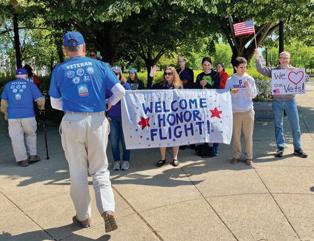
Since 2022, this nonprofit, allvolunteer group has honored WWII, Korean War and Vietnam War-era veterans by taking them on an all-expenses-paid trip to Washington, D.C., to visit veteran memorials and monuments. The next trip is slated for spring 2025. Info: honorflightcfa.org
Accepts veterans who served anytime since 1941 and were honorably discharged or still serving active military duty. Local posts include:
• Post 10 in Wilmington nclegion10.org
• Post 167 in Hampstead ncalpost167.org
• Post 129 in Pleasure Island pleasureislandpost129.com and others.
Another nonprofit veterans service organization for veterans (or those currently serving) who also served in “in a war, campaign, or expedition on foreign soil or in hostile waters.”
The Wilmington Post 2573 facebook.com/ vfwpost2573canteen


meals provided through the Grocery Giveaway

76,500 120,328 54,000
hot meals served in the Soup Kitchen

men, women, and children sheltered overnight
235

individuals utilizing Day Shelter services
169
25 campuses volunteers 500 7 programs 3

meals delivered to rehoused seniors and families
365 221

individuals served through the free on-site Medical Clinic

men, women, and children returned to a safe, stable home of their own
48

chronically homeless adults rehoused with supportive services at SECU Lakeside Reserve and the Sgt. Eugene Ashley Center

homeless Veterans re turned to independent housing through the Sgt. Eugene Ashley Center
Our mission is made possible through the support of donors, volunteers, and community partners. Get involved today at www.goodshepherdwilmington.org.

Good Shepherd Center’s Capital Campaign Home for Good will:
• Create more than 50 apartments for chronically homeless individuals with disabilities, including seniors and Veterans;
• Expand our homeless services campus, including a new family shelter with expanded capacity, dedicated play space and rehousing supports;
• Build on 40+ years of service to the Cape Fear community, using Best Practice , data driven interventions to help homeless individuals and families transition to permanent housing, stability, and an improved quality of life
Our newest Permanent Supportive Housing community is fully funded and will rehouse 32 chronically homeless adults with disabilities by providing an affordable apartment combined with on-site supportive services. The land for this campus was generously donated by the City of Wilmington.



Good Shepherd is turning our attention to fundraising for our expanded Martin Street campus, which will include a new family shelter with double our current capacity, additional services space for homeless adults, and more Permanent Supportive Housing for our most vulnerable homeless neighbors. We are actively looking for support to help us bring this new campus to life!
Please join us in being a part of the solution. Last year, Good Shepherd ended the homelessness of 169 adults and children through a path back to safe, stable housing. With your support, we can do so much more! We invite you and your family, business, congregation, or organization to get inv olved in this important work. Reach out to our team to schedule a tour, to plan a volunteer opportunity, or to talk with us about homelessness in our community and the solutions that you can invest in that provide a better quality of life for all residents of our shared Cape Fear home. Call 910-763-4424 ext. 104 or email kknight@goodshepherdwilmington.org to connect!

university of North Carolina Wilmington
professor Kirk Brown has been encouraging his students to do their best for the past 23 years.
From 2000 to 2018, he was also the program director for athletic training education. Now, he focuses his teaching at the UNCW School of Health and Applied Sciences as an associate professor.
But he doesn’t stop there.
After losing his father to cancer, Brown inherited his woodshop tools including his wood lathe, a tool that rotates a wooden piece on an axis allowing a cutting tool to shape the piece into the desired design.
While he had a little experience in making pens, he decided to utilize his inherited tools by turning his two-car garage into a functional workshop.
“After organizing my tools, I began teaching myself how to use the wood lathe to turn pens,” Brown said.
“There have been a lot of learning curves and many mistakes and frustrations,” he added. “I kept at it, and, after a year of practice, I started seeing all of that time paying off. After purchasing all the nec essary tools and supplies required to make the pen, it became evident that I needed to devise a plan to finance this hobby.
“It was only after a year that my wife and I started to explore ways to sustain this hobby, which had significant overhead expenses.”
Woodturning is an art that takes dedication and perseverance, but the results can be timeless pieces that are passed on for generations.
“Woodturners can generally be divided into two groups: bowl turners and spindle turners,” Brown said. “As a spindle turner, I focus on crafting pens and handles for a range of items, such as pizza cutters, bottle openers
Interested in finding out more about the art of woodturning?
Here are some local organizations that focus on it.
The club was created to “support and build a community of new and experienced woodturners in the Cape Fear region through teaching, training, and demonstrations.”
Info: wawawoodturners.org
The woodturners group also hosts events for female woodturners of all skill levels to learn from each other and share lathes and tools.
Info: wawawoodturners.org, check the club’s events calendar for Women in Turning meetups
Kids Making It is a local youth woodworking program. With the help of volunteers, at-risk youth learn woodworking and woodturning techniques while also picking up business skills by selling their goods at the nonprofit’s retail store.
Info: kidsmakingit.org , 617 Castle St.
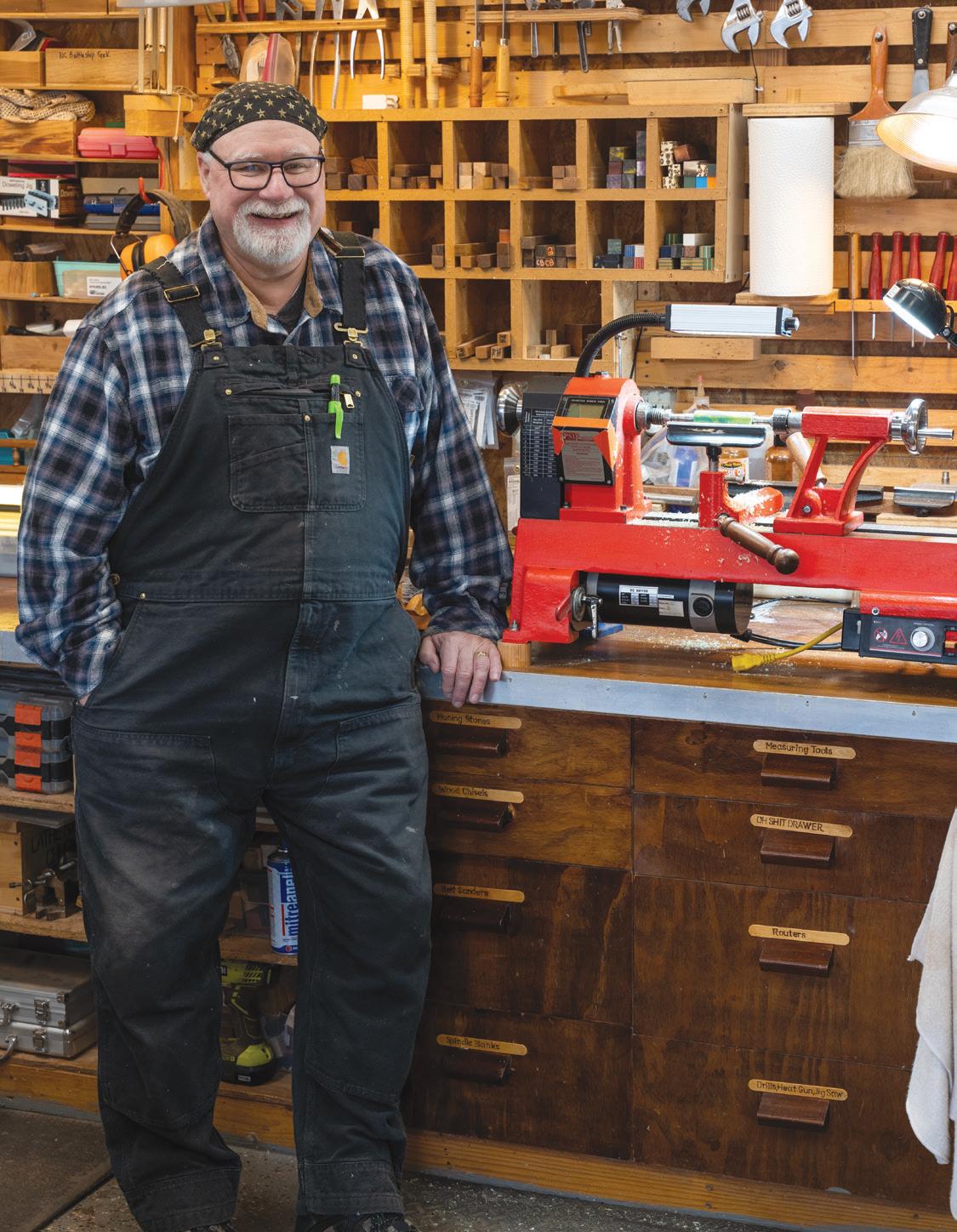
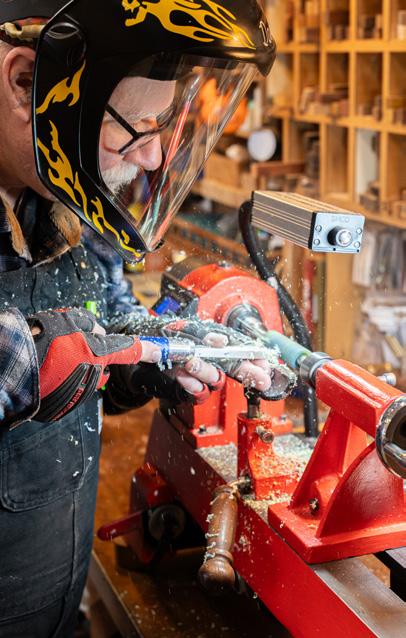
and ice cream scoops. What I love about woodturning is the ability to transform an unremarkable piece of wood into a beautiful pen that can be cherished for a lifetime.
“There are also the technical and detailed aspects of woodturning that appeal to me, such as matching wood grain when gluing two pieces together or matching wood texture with the appropriate wood finish.”
Those who know “Doc” Brown know the attention to detail he puts into his work whether as a woodturner or as an instructor. He is proud of his creations and how they are viewed by those around him.
“I have a few pens that I am especially proud of,” he said. “The very first one I ever made was for Dr. Bennet Omalu, who was giving a lecture at the UNCW campus. Since Dr. Omalu originally came from Nigeria, I decided to source some wood from that region to create the pen. I presented it to him
during a lunch event in front of the university’s deans and chancellor.
“After receiving the pen, Dr. Omalu told me that he would display it alongside the pen that President Barack Obama had given him! I also had the pleasure of making a pen for Kareem AbdulJabbar, a former Lakers player.
Brown recalls once making a pen out of 34 segments of wood.
“I wasn’t sure if it would hold together while I was turning it on the lathe,” he said. “However, once I completed it, it turned out to be stunning. One of our good friends bought the pen and now keeps it in his office as a display piece.”
Brown, whose Facebook page is at facebook.com/ docbrownswoodshop, showcases and sells his creations at craft fairs in the area throughout the year.
He often can be found at the Historic Downtown Wilmington Marketplace, which takes place on Sundays between April 14 and Oct. 27 from 10 a.m.-3 p.m.
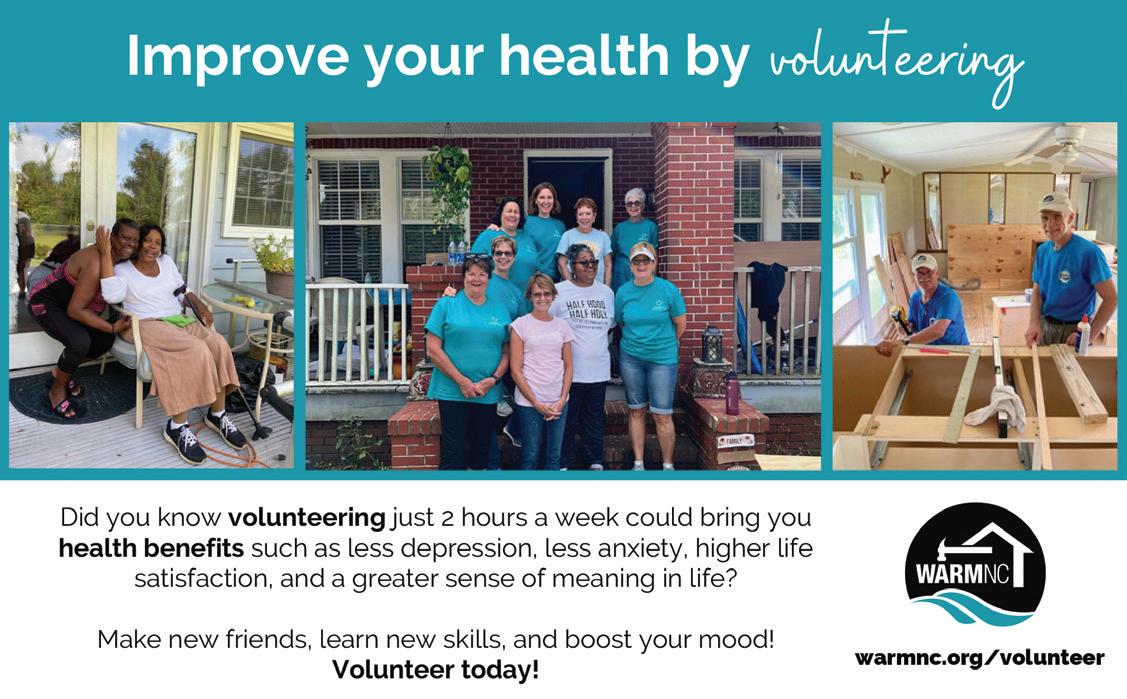





there are a lot of food options in Wilmington – vegan, international and, of course, Southern – but what of those who miss their taste of home?
Joe’s Oasis brings a taste of Pennsylvania with its pierogies. Maine Lobstah Shack has just that: authentic lobster from Maine. Brooklyn Café goes farther south with a taste of beignets from Louisiana. Port City Plates is a call home to New York, specifically Rochester. And S & L New York Style Deli has a direct pipeline, its bagels and rolls hailing from the Big Apple and baked daily.
These are just a few of the restaurants bringing a unique taste to the area – a piece of a notforgotten life to those who have moved here from other areas of the country, or a new experience for the native Wilmingtonian.
2317 S. 17th St., Wilmington | sldeli.com/about
Channeling the ubiquitous New York City corner deli, S&L’s owners have built their lineup around city favorites for their breakfast and lunch menus.
There are bread items from New York, such as New York-style egg sandwiches, and well as stacked Boar’s Head meats-and-cheeses rolls. Customer lunch favorites include the Godfather (an Italian combo), Penn Station (Reuben), and Downtown (Philly cheesesteak) as well as those with classic NY names including the Liberty, Yankee Stadium, Times Square and Central Park.
The family-owned and -operated deli draws former New York residents as well as hospital staff because of its proximity to Novant Health NHRMC’s main campus on 17th Street.
Louie and Tami Natoli, moved to Wilmington in 2005 from Stony Point, New York, and opened the eatery, which is owned by Louie and Tami's brother Steve Ercole.
Their dessert menu also is New York-inspired and features New York-style cheesecake and sfogliatella, a shell-shaped Italian pastry. And they offer catering services as well.


706 N. 4th St., Wilmington facebook.com/BrooklynCafeNC
A neon “Beignets All Day” sign greets customers coming to Brooklyn Café looking for a taste of New Orleans.
Brooklyn Café is a restaurant that serves, according to coowner Rodney Robbins, “made from scratch and served hot” beignets from his mother’s recipes.
Beignets, with their origin in France, migrated from their home country to New Orleans – a center of culinary creation in the South.
Rodney and Marilyn Robbins brought that taste to the Brooklyn Arts District near downtown Wilmington.
Brooklyn Café’s beignets and donuts are a simple and delicious choice. There are even vegan beignet options.
The cafe also is quickly becoming known for its Java Estate coffee and wine and beer options.

Maine Lobstah Shack
411 Roland Avenue, Surf City | mainelobstahshack.com
You can hear Maine in the name – Maine Lobstah Shack has brought lobster rolls to Surf City since 2021.
Maine Lobstah Shack was started by a family from Maine that moved to the area in 2015, according to its website.
Those from the Northern coast will be familiar with Maine’s lobster rolls – a signature dish for the restaurant and the region. Maine Lobstah Shack’s lobster roll ingredients are local to their original home: lobster from Maine and rolls from New England.
“A processor in Maine cooks the meat, then it’s fresh, never frozen and delivered to the restaurant,” co-owner Trevor Dostie said. There are variants of this dish on the menu, such as “Lil Surfer Lobster Roll.” The Maine Roll is its most popular.
The Shack – as it is called on the website – can also be found around town with its newly launched food truck.
portcityplates.com | facebook.com/PortCityPlates (for food truck locations)
Trash plates are said to originate in New York, specifically Rochester. They are a mingling of American street food, such as hot dogs and hamburgers, combined together with sauces and a base of home fries.
Port City Plates boasts “Rochester Style Trash Plates” with a Wilmingtonian twist – the names of the trash plates are all well-known, local areas, such as the Wrightsville Beach option.
Their main customer base is from “Western New York to include Rochester, Syracuse and Buffalo – go Bills!” said Shelly Marketell, who owns Port City Plates with her husband, Rob.
Their best seller is the Carolina Beach plate, followed by the Cape Fear plate.
Port City Plates is a food truck that brings authenticity out and about. The owners are from Western New York and therefore have experienced the real deal and brought it to Leland when they moved.


6400 Carolina Beach Road, Unit 10, Wilmington | joesoasis.com
Under its “Taste of Pittsburgh” section, Joe’s Oasis has housemade pierogies on the menu. The cheese-and-potato-stuffed dumplings are topped with the classic garnishes of onion and butter and laid on sour cream.
Joe’s Oasis was opened by a “born and raised” Pittsburgh, Pennsylvania, native Cathy Krizner, according to the restaurant’s website. Opening the eatery in Masonboro Commons in 2013 as a tribute to Krizner’s late husband, the neighborhood bar strives to bring a step above pub food to the area.
Pierogies are a signature dish – and can be pre-ordered by the dozen –but there are other tastes of Pittsburgh, such as Isaly’s chipped ham or a turkey Devonshire.
The bar’s patrons also can order Iron City and I.C. Light beers from Pittsburgh Brewing Co.
You can also find pierogies on the menu at Whiskey Trail, 4039 Masonboro Loop Road and 3525 Lancelot Lane, where varieties include the Masonboro with bourbon pork belly, onions and white cheddar and the Philly with shaved ribeye, grilled mushrooms, onions, green peppers and queso.

RETIREMENT COMMUNITIES
Brightmore of Wilmington 2324 41st St. Wilmington, NC 28403 (910) 350-1980
BrightmoreOfWilmington.com
Cambridge Village 75 Cavalier Dr. Wilmington, NC 28405 (910) 239-9500
CVSLiving.com
Carolina Bay at Autumn Hall 630 Carolina Bay Dr. Wilmington, NC 28403 (866) 455-0599
CarolinaBayAtAutumnHall.com
Inspire Brunswick Forest 6146 Liberty Hall Dr. Leland, NC 28451 (910) 239-2605
InspireBrunswickForest.com
Porters Neck Village 1200 Porters Neck Rd. Wilmington, NC 28411 (866) 825-3806 PortersNeckVillage.org
COMMUNITIES
Village at River Landing 131 River Village Pl. Wallace, NC 28466 (888) 285-4171
RiverLanding.com
HEALTH CARE
AFC Urgent Care Wilmington 348 College Rd. Wilmington, NC 28403 (910) 343-8209
AFCUrgentCare.com
Dawson Med 608 Dawson St #101 Wilmington, NC 28401 (910) 387-3788
Dawson-Med.com
Helping Hands of the Cape Fear (910) 447 9737
HelpingCapeFear.com
Wilmington Awning, Shutter & Shade
730 Saint James Drive
Wilmington, NC 28403 (910) 799-2782
WilmingtonAwning.com
BANKS & FINANCIAL ADVISORS
Excite Credit Union
237 Racine Drive
Wilmington NC 28403 (910) 798-9576
ExciteCU.org
Morgan Stanley Financial Advisors
1111 Military Cutoff Rd.
Wilmington, NC 28405 (910) 509-1100
Advisor.MorganStanley.com
TD Bank
802 College Rd.
Wilmington, NC 28403 (910) 792-0131
TD.com
United Bank
115 N 3rd Street
Wilmington, NC 28401 (910) 726-1510
BankWithUnited.com
Wrightsville Wealth Management
1985 Eastwood Road Landfall Park North, #110 Wilmington, NC 28403 (866) 275-4477
Advisors.UBS.com/Wrightsville
INSURANCE AGENTS
James E. Moore
Insurance Agency 1508 Military Cutoff Rd. #104 Wilmington, NC 28403 (910) 256-5333
JamesEMoore.com
TRAVEL/ ENTERTAINMENT
theArtWorks 200 Willard St Wilmington, NC 28401 (910) 352-1822
TheArtworks.co
Wilmington Symphony Orchestra 5032 Randall Pkwy
Wilmington, NC 28403 (910) 791-9262
WilmingtonSymphony.org
Wilson Center 703 N 3rd St. Wilmington, NC 28401 (910) 362-7999
WilsonCenterTickets.com
Wilmington International Airport 1740 Airport Blvd. Wilmington, NC 28405 (910) 341-4125
FlyILM.com
Girl Scouts-North Carolina Coastal Pines 2250 Shipyard Blvd #3 Wilmington, NC 28403 (800) 284-4475
NcCoastalPines.org
Good Shepherd Center 811 Martin St. Wilmington, NC 28401 (910) 763-4424
GoodShepherdWilmington.org
United Way of the Cape Fear Area 127 Grace St. Wilmington, NC 28401 (910) 798-3900
UWCFA.org
Wilmington Area Rebuilding Ministry (WARM) 909 Market St. Wilmington, NC 28401 (910) 399-7563
WarmNC.org
City Of Wilmington 102 North Third St. Wilmington, NC 28402 (910) 341.7800
WilmingtonNC.gov

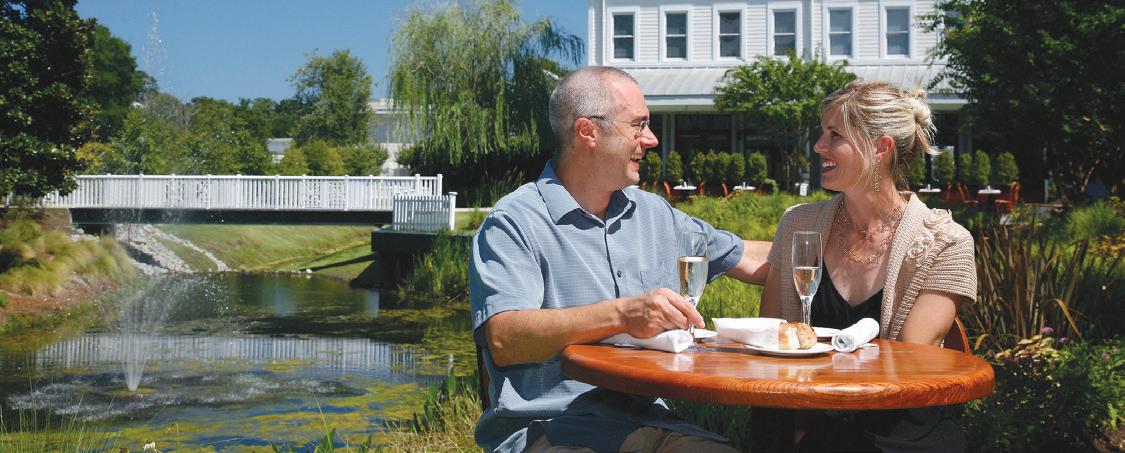
Outdoor dining spaces add another dimension to dining in the Port City and, in some cases, take a restaurant’s brand to new heights.
They seem to be popping up everywhere like mushrooms overnight – outdoor patio and garden spaces conceived and constructed on premises by local restaurants and eateries to keep customers, boost business and build their brands.
Whether big, small, homemade
or contracted out, the city’s outdoor dining spaces have almost become ubiquitous.
“It was really important we had outdoor space,” said Kristian Bawcom, owner of the recently opened Four Corners restaurant at 2025 Eastwood Road, close to Wrightsville Beach. “It was under construction from day one.”
Facing Eastwood Road and running the length of the building, Four Corners’ patio is wide and spacious, as it spills out from the main building through glass doors onto a concrete slab boasting 18 teak tables and chairs, multiple TVs, a fire
pit and string lights.
Dark-stained decorative louvered shutters on the structure side of the patio lend a relaxed, tropical feel.
Above the porch entrance, like a low-hanging cloud, sits Four Corners’ sky-blue neon sign, the name a reference to an offensive strategy in basketball popularized by celebrated Chapel Hill basketball coach Dean Smith.
The original Chapel Hill-based Four Corners restaurant – and subsequently the inspiration behind the Wrightsville Beach location – is also owned by Bawcom.
Bawcom pointed out that an
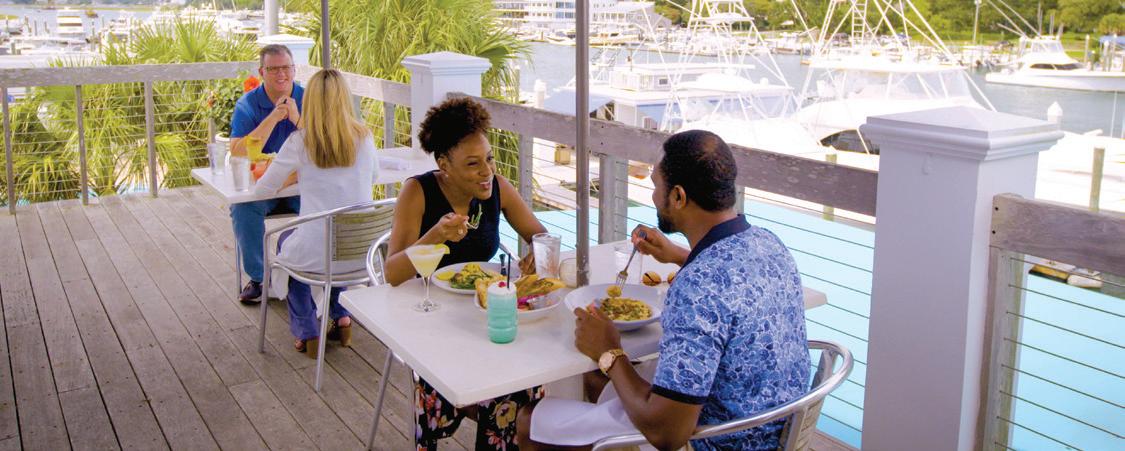
outdoor space existed on the onetime site of Soundside restaurant, formerly Boca Bay.
“There were six to eight tables and a firepit, but there was no real design,” he said. “You’re definitely going to have to spend some money to make (a space like this) comfortable.”
Four Corners’ future patio plans include an outdoor bar with 14 seats and an awning.
It’s been worth every penny, said Bawcom, a surfer who grew up in South Florida.
“Every evening, this patio is full,” he said, noting that it’s too early to tell about the patio’s overall economic impact, as the restaurant just opened on April 17. “But what I can tell you is sales have been very consistent.”
Bawcom turned and ordered an unsweet tea as palm fronds in the background bristled and a breeze swept across the patio. “It just has a really cool vibe out here,” he said. “And customers love it.”
Cool vibes, along with trying to boost the bottom line through outdoor dining, are something Carl Cross also knows about.
“Having outdoor space boosts business,” said Cross, who along with business partners Andrew Dennison and Dean Moore own The
Half sandwich shop and taproom at 510½ Red Cross St., the former home of Detour Deli. “It’s all about getting customers into seats. The patio helps us do that.”
Extra beer sales to quench parched tongues from outdoor noshing and nattering, said Cross, is just one example of an economic multiplier. With limited seating inside the low-profile, brick building, Cross said he and his business partners have come to rely on the outdoor space.
“In spring and fall, overflow is actually inside,” said Cross, referring to the patio’s popularity.
He said the rise of such spaces locally boils down to one factor: “You’re in a beautiful beach town. Who doesn’t want to be outside?”
The Half’s patio is a cozy, fencedin back lot with decking, brick and gravel. It holds six picnic tables and, at the far end, homemade benches and a fire pit.
“The patio’s construction was self-funded,” said Cross, pointing to bench legs made of local, reclaimed wood. “We did it ourselves – we enjoy problem solving.”
Like Four Corners, The Half’s patio also had a former life.
“A patio footprint existed, but it only had two picnic tables and was underutilized,” Cross said.
Minutes passed, and a lunchgoer stepped out the rear exit onto the sunny patio and passed by. “I’d rather sit outside, it’s so cute,” the customer said.
As Cross got up from a picnic table, he made a confession.
“I personally prioritize restaurants with outdoor space,” he said. “Anybody thinking about doing it should. It’s definitely worth it.”
In the 200 block of Market Street, pizzeria and beer garden Ponysaurus Brewing Co., which opened in January, didn’t horse around when planning an outdoor eating and drinking space.
Covered and uncovered areas with picnic tables, umbrellas and a large outdoor fireplace welcome guests into a hideaway garden that seems far removed from busy Market Street.
“We opened our outdoor beer garden and front patio earlier this year,” said co-owner Nick Hawthorne-Johnson. “We created our terraced outdoor dining space, which used to be a parking lot, as a hideaway for drinking beers, eating and connecting with friends. Our front patio is a beautiful place to overlook downtown Market Street with a beer in hand.”


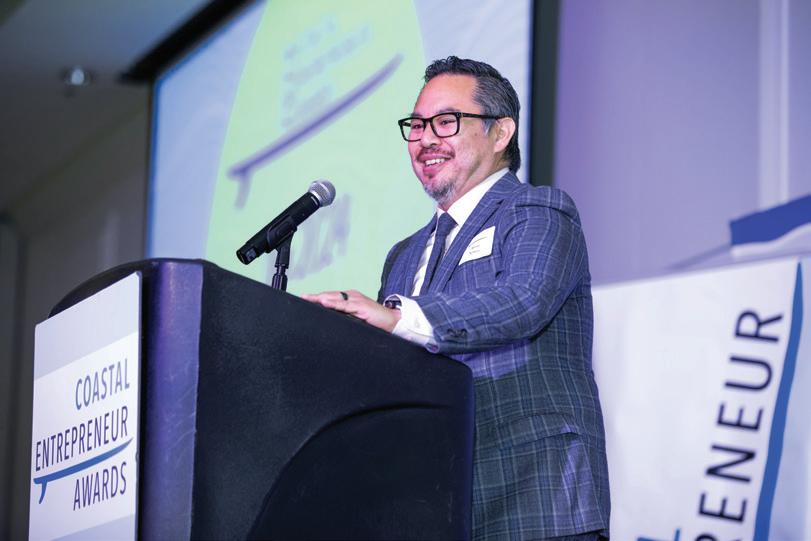
Wilmington-based health technology company Predicate Healthcare Performance Group (HPG) has been drawing attention in recent months.
Predicate uses its AI software platform, OpenDX, to help health care providers diagnose sepsis. The technology will likely expand to help treat a host of illnesses in the future.
Morris Nguyen, co-founder and CEO of the AI health care company, said he and his team are in the midst of completing clinical trials around the world to compile a diverse dataset for the technology.
“Right now we’re hyper-focused on finishing our clinical trials,” Nguyen said. “We are traveling to Ghana, the Philippines, to Ireland later this year. And then once we’ve finished our clinical trials, then we can start implementing.”
The company in May was named Coastal
Entrepreneur of the Year as part of the annual Coastal Entrepreneur Awards, a joint program between the Greater Wilmington Business Journal and University of North Carolina Wilmington’s Center for Innovation and Entrepreneurship.
The same week, Predicate also took home $10,000 for third place in the N.C. Biotechnology Center’s NC Biotech Venture Challenge Southeastern Venture Pitch Finals.
It was also among the 125 companies selected by the Council for Entrepreneurial Development to pitch to an audience of hundreds of investors at CED Venture Connect this spring. And Predicate was included in the 12-week Raleigh-based RIoT Accelerator Program this year.
The intersection of medicine and technology sits at the core of Predicate.
Predicate uses a chest sensor to aid health care workers in detecting signs of sepsis. Sepsis is a deadly reaction to infection in the body. But the signs of this condition are difficult to diagnose and easy to miss, Nguyen said.
After pitching Predicate to a room of other

entrepreneurs and investors, Nguyen said people have one of two reactions: They either know someone who has gone through sepsis and note how important his technology is, or they did not know sepsis was a big issue in the health care field.
Sepsis can present in many forms depending on the patient. Nguyen’s team aims to use Predicate’s product – a mix of the sensor, recorded verbal cues and artificial intelligence monitored by a physician – to catch early signs of sepsis regardless of the form.
“There is an algorithm in the software that looks at arrhythmias because arrhythmias detection is important for sepsis,” he said. “And then we also look at respiratory rate and temperature. That’s all from just that one chest sensor.”
The company started as a consulting firm in 2018, Nguyen said. It transformed into its current form in March 2023.
He and his co-founder, Kody Roza, pivoted the company using what they had learned as medical consultants.
With its renewed focus, Nguyen and Roza have traveled around the world, speaking in South America, Asia, Europe and Africa.
Nguyen’s ability to grow and scale a technology business in Wilmington is a testament to the region’s mounting influence as a technology and health care hub. Being a part of an early-stage ecosystem with such potential is exciting, he said.
The Predicate team has big plans for this year by diversifying the training data for the AI model embedded in its software by traveling internationally. They also plan to continue to train the model in the U.S.
“It’s our responsibility as AI tech developers to train our models on the most heterogenous diverse patient cohorts possible,” Nguyen said. “And also, it allows us to show the world what we’re creating and how we can impact health care delivery.”

Founded by Grey Vick, Grey Outdoor advertising is a remarkable local success story. Grey was born in Wilmington, NC and is a proud graduate of UNCW. Starting with a single billboard in 2014, Grey Outdoor Advertising has always been guided by its deep roots in and love for this community. With incredible growth to over 700 billboard faces across the Carolinas, the company has been able to share their success and give back in big ways to this region.
Grey strongly believes in the power of supporting local causes. Having built a reputation as a high-quality provider of creative advertising solutions for various businesses across our state, Grey now has the privilege of integrating his passion for philanthropy into the core values of his business by donating advertising space to local charities and causes to promote awareness.
Grey Outdoor Advertising is committed to making a difference in the businesses and communities it serves. Giving back impacts lives!

 BY ELIZABETH WHITE | PHOTO BY MEGAN DEITZ
BY ELIZABETH WHITE | PHOTO BY MEGAN DEITZ
With its airy, modern, detailed design one could think upon entering into The Grove that it is a downtown restaurant or a trendy spot located in the Cargo District.
Instead, the restaurant, which isn’t open to the public, serves the employees of Live Oak Bank.
The Grove is not simply a runof-the-mill employee cafeteria. The carefully designed space combines a well-crafted industrial kitchen with a coffee shop-esque vibe that offers gourmet, foodie-style meals.
Lottie Arnold is the woman behind the scenes that made it all happen.
A Wilmington native and former owner of her catering business, Southern Thyme, she was given the reins by Live Oak Bank chairman and CEO Chip Mahan in 2015 to create a space that would keep employees on the campus happy and well-fed. Mahan had already experienced Arnold’s expertise when she catered his daughter’s wedding a couple of years ago.
“The Grove exemplifies an undercurrent of goodwill,” Arnold said. “Chip firmly believes if you take care of employees, then in return, they will take care of customers.
“And food is always a good starting point,” she added. “He trusted us to do the job and gave us whatever tools we needed and never checked in. My goal was to use food to make everyone happy and create a welcoming gathering spot as well.”
The Grove and now its sister cafe, The Coast, are like Arnold’s own children.
Pleasing 400 employees was no small task, but Arnold had her vision and stuck to it. Mahan had been working with a previous designer, but “the space, although pretty, was not
functional and was really a step up from a college dining hall,” she says.
Arnold’s vision was to create a Whole Foods-style environment that served healthy and delicious meals. She is passionate about food, and it is reflected in her staff as well.
Some of her employees have gone to culinary school, and “most of the staff has a deep knowledge of food and working in restaurants,” she said.
Her attention to detail and commitment to her craft are what the employees and staff notice most.
“Her expertise in food/customer service is unmatched,” said David Cameron, The Coast’s head chef. “From food preparation to each table setting, each detail is carefully planned with the customer in mind.”
The Grove serves breakfast and lunch to all Live Oak Bank employees and staff. There are grab-n-go meals for employees working over the weekend.
Arnold oversees 14 staff members at The Grove, and bank employees can choose from cold and hot buffets along with four a la carte stations. The Grove seats 121 people and another 30 people outside. The company uses the restaurant space to hold special events as well.
A memorable time for Arnold was the first meal she ever served at The Grove.
“It was an all-hands-on-deck meeting including all 400 employees at that time,” she said. “No pressure at all,” she joked. The picnic-themed event was a success and an indicator of more to come.
With the success and continued growth of Live Oak Bank, came the demand for another eating space. The Coast, a mini version of The Grove, came about in 2017 and resides in a different location.
Again, Arnold was called on for its design.
“I was given a footprint and just went with it,” she said.
Both facilities complement but do not compete with each other. Located in the basement of a smaller
building, employees on the bank campus’s Building 3 have to “resist being lured like zombies by the aromas of food and garlic,” said Madison Carlos, vice president of corporate communications. She should know since she has her office in the building. The Coast is a grab-n-go spot with no cashiers and self-order kiosks.
What keeps the employees coming back and staying on campus is the popular rotating menu and specially planned themes thought out by Arnold and her team. Indian, Italian and a Chick Faux Lay day are some favorites. At The Coast, employees have been treated to a Blue Plate day, and recently, Earth Day with a rainbow theme.
“My staff are really foodies at heart,” Arnold said.
For the team, planning menus is not so much work as fun.
They are constantly thinking of ways to interject new ideas and food trends into their meals and feel strongly that “nothing is better than serving a gorgeous meal in a beautiful place.”
Such dishes employees can choose from include a Korean Blue Plate with gochujang fried wings with Yum Yum sauce, sweet and spicy banchan slaw or brined and grilled pork chops with herbed chimichurri.
It is obvious that Arnold has taken her past livelihood and turned it into a second chapter.
“I plan to be here until I retire,” she said.
Mahan (who loves the Reuben sandwiches and breakfast offerings) is proud of what Arnold has accomplished and brought to the company.
“I’d like to think the restaurants have made a difference,” he said. “Both The Grove and The Coast are places for our folks to congregate, collaborate and work while enjoying delicious food. Everything they do is first class.”
For more restaurant news, sign up for the weekly Feast Unwrapped email newsletter by going to FeastWilmington.com.
Merv, the titular character in an upcoming comedy feature movie, takes a break between scenes in late April. Filming took place at the Hurricane Alleys restaurant on the Carolina Beach Boardwalk in the above photo, but other locations around the city also were used for the movie starring Zooey Deschanel and Charlie Cox. Hurricane Alleys has been used for other productions such as HGTV shows and Florida Man , said owner David Cole.
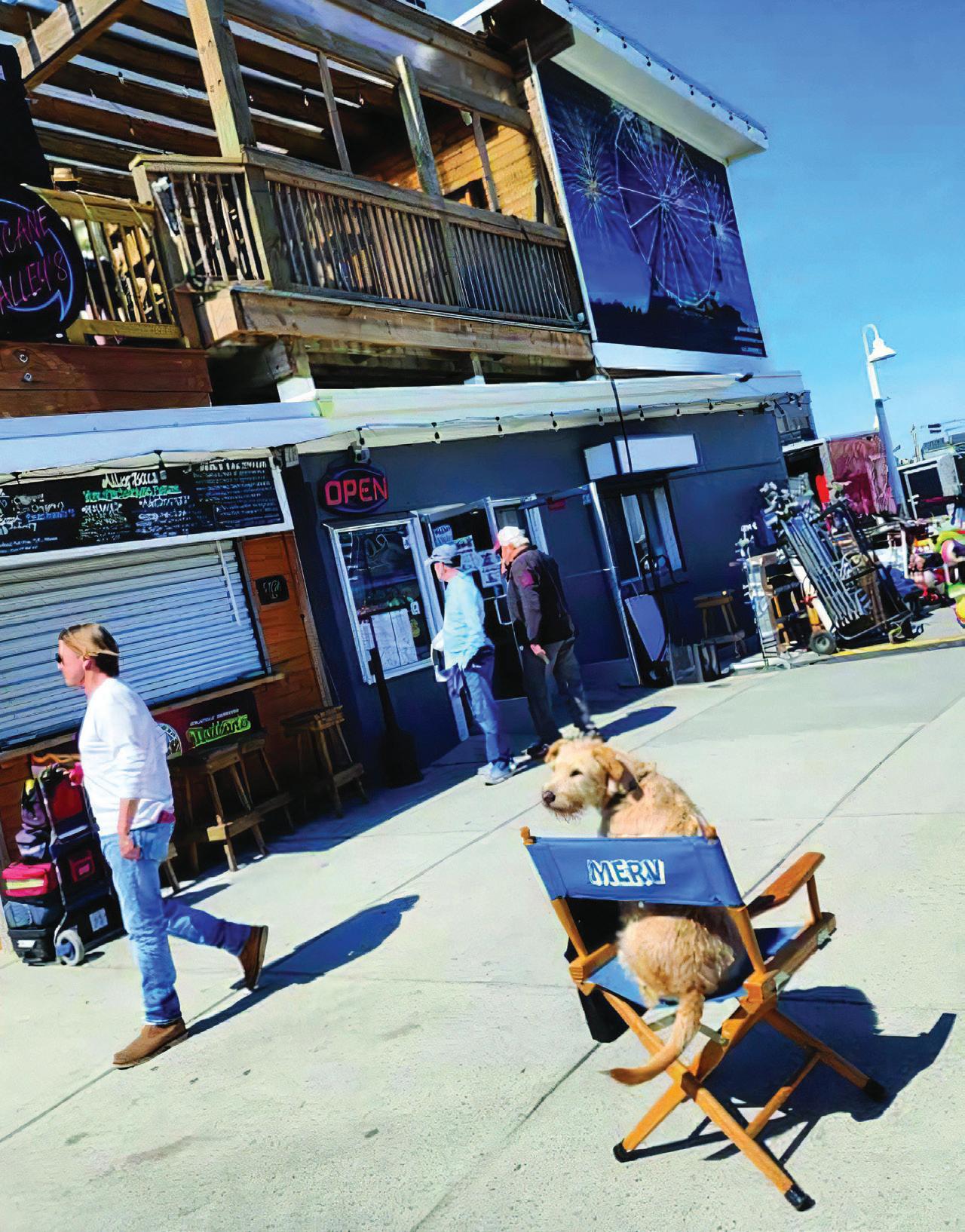 BY DAVID COLE
BY DAVID COLE
